The History Of The Actors’ Group (TAG)
2010-2011
| Compiling the history of any organization can be a great challenge, particularly when the core group is small and rather than chronicle events soon after each production was completed, had spent their energy towards merely keeping alive. So is the case with TAG. As it evolved from a creative curmudgeon to new theater kid on the block and then to becoming one of Hawaii's finest community theaters, all TAG could do was focus on its next production, for it had little time for anything else. Hence, this history has been cobbled together utilizing the recollection of participants at the time, dog-eared old files containing memorabilia and other information, photos that fortunately was taken then buried, newspaper articles, and recovered video footage that is often way past its prime if not damaged. Nonetheless, these are the sources to create the history of The Actors' Group, told in a series of posts chronicling time periods unique to its development. |
 HSTC once again held its awards at the Koolau Ballroom, where TAG would receive a total of 17 Po’okalas for the 2009-2010 season. These involved: Leading Male in a Play, Russell Motter, November, Allan Okubo, Miso; Leading Female in a Play, Betty Burdick, Happy Days, Jessica Kauhane, Miso; Featured Female in a Play, Elissa Dulce, Miso; Featured Male in a Play, William Ammons, The Piano Lesson, Eric Nemoto, Miso; Ensemble Play, Night of January 16th, Topdog/Underdog; Director of a Play, Harry Wong III, Topdog/Underdog; Overall Play, Night of January 16th, November, Topdog/Underdog; Set Design, Andy Alvarado, Topdog/Underdog, Andy Alvarado/Brad Powell, Miso; Light Design, Thomas Tochiki, Miso; and for her great direction of Susan Shirwen’s Miso, a Non-Resident Guest Artist award, for Clare Davidson, Director, Miso.
HSTC once again held its awards at the Koolau Ballroom, where TAG would receive a total of 17 Po’okalas for the 2009-2010 season. These involved: Leading Male in a Play, Russell Motter, November, Allan Okubo, Miso; Leading Female in a Play, Betty Burdick, Happy Days, Jessica Kauhane, Miso; Featured Female in a Play, Elissa Dulce, Miso; Featured Male in a Play, William Ammons, The Piano Lesson, Eric Nemoto, Miso; Ensemble Play, Night of January 16th, Topdog/Underdog; Director of a Play, Harry Wong III, Topdog/Underdog; Overall Play, Night of January 16th, November, Topdog/Underdog; Set Design, Andy Alvarado, Topdog/Underdog, Andy Alvarado/Brad Powell, Miso; Light Design, Thomas Tochiki, Miso; and for her great direction of Susan Shirwen’s Miso, a Non-Resident Guest Artist award, for Clare Davidson, Director, Miso.
The Great Move To Dole And The Start Of TAG’s New Era
 In two years of occupancy at the Mendonca Building in Chinatown, TAG had experienced numerous challenges which fueled a general feeling of discontent that had been brewing from the moment the first great move of the theater had been completed. To be certain, the move to Mendonca was absolutely critical. Had TAG not made the move when it did, it wasn’t out of the question that it would have never moved at all, and if that were the case, its eventual demise would have inevitably happened. And, this was made possible by Mendonca making concessions to the amount of square footage that TAG could take over. In other words, at first, TAG was offered a larger area, which also correspondingly would mean a much greater rent, an amount that was outside TAG’s budget. But because the landlords were willing to redraw the lines of what TAG could occupy – a smaller area yet sufficient enough to be greater than the space TAG occupied in the Yellow Brick Studio back in Kaka’ako – the move was made possible. However, after TAG moved in a number of disappointments would ensue. For one, the beautiful courtyard, a grassy area lined with beautifully landscaped trees and shrubbery, would be off limits when TAG proposed (and followed through on) a fundraiser. From TAG’s perspective, this was not only ludicrous, but also something that was not made clear when it was considering the move. The courtyard was pointed out as being an optimum area to hold an event. This was a critical element in its decision to relocate. The fact that this area was not to be used and that only the surrounding concrete walkways was where patrons could walk was deeply dissatisfying.
In two years of occupancy at the Mendonca Building in Chinatown, TAG had experienced numerous challenges which fueled a general feeling of discontent that had been brewing from the moment the first great move of the theater had been completed. To be certain, the move to Mendonca was absolutely critical. Had TAG not made the move when it did, it wasn’t out of the question that it would have never moved at all, and if that were the case, its eventual demise would have inevitably happened. And, this was made possible by Mendonca making concessions to the amount of square footage that TAG could take over. In other words, at first, TAG was offered a larger area, which also correspondingly would mean a much greater rent, an amount that was outside TAG’s budget. But because the landlords were willing to redraw the lines of what TAG could occupy – a smaller area yet sufficient enough to be greater than the space TAG occupied in the Yellow Brick Studio back in Kaka’ako – the move was made possible. However, after TAG moved in a number of disappointments would ensue. For one, the beautiful courtyard, a grassy area lined with beautifully landscaped trees and shrubbery, would be off limits when TAG proposed (and followed through on) a fundraiser. From TAG’s perspective, this was not only ludicrous, but also something that was not made clear when it was considering the move. The courtyard was pointed out as being an optimum area to hold an event. This was a critical element in its decision to relocate. The fact that this area was not to be used and that only the surrounding concrete walkways was where patrons could walk was deeply dissatisfying.
 But this “bait and switch” matter wasn’t the only thing. In fact, there were many other issues. For one, there was the theater’s air conditioning, something that had always been a problem back on Keawe Street, was not only equally as bad at Mendonca, considering the electricity bill was separate, was even worse. When the need to repair the AC was made to the landlords, it was met with responses that the building’s maintenance man would get on it right away. But of course, this almost never happened. It would take weeks for the AC to be repaired and always the maintenance man would be defended with comments that he was trying his best, he needs to get a part, he actually works part-time as the maintenance man (for he ran a restaurant), and that he’s really a good guy. All these in of itself were true, however the bottom line was that conditions in the theater, particularly when a show attracted a good house, would be near sweltering. Then there was the case of rats. At Yellow Brick Studio, patrons would occasionally see a rat running across the light racks atop the tiny stage. At Mendonca, while there was never an actual sighting, what audience members would hear during a performance, was the sound of what could only be a “herd” of rats running inside the ceiling. Of course, there was always the issue of parking and security. Mendonca was in the heart of Chinatown, where there was no free parking, and which also came a bevy of safety and sanitization issues. Leaving the theater, actors would have to cross Smith Street and then walk to North Pauahi Street, and cross it to get to the elevators that would take them to the municipal parking garage underground (the usual parking place for anyone associated with the theater, and generally at least $3.00 a day). Not a particularly challenging thing to do during the day time, but considering actors would typically make that trek late at night after rehearsals and shows, it seemed to be an accident waiting to happen. The area would be a gathering spot for homeless people and in front of the theater entrance there had been instances of feces appearing on the sidewalk.
But this “bait and switch” matter wasn’t the only thing. In fact, there were many other issues. For one, there was the theater’s air conditioning, something that had always been a problem back on Keawe Street, was not only equally as bad at Mendonca, considering the electricity bill was separate, was even worse. When the need to repair the AC was made to the landlords, it was met with responses that the building’s maintenance man would get on it right away. But of course, this almost never happened. It would take weeks for the AC to be repaired and always the maintenance man would be defended with comments that he was trying his best, he needs to get a part, he actually works part-time as the maintenance man (for he ran a restaurant), and that he’s really a good guy. All these in of itself were true, however the bottom line was that conditions in the theater, particularly when a show attracted a good house, would be near sweltering. Then there was the case of rats. At Yellow Brick Studio, patrons would occasionally see a rat running across the light racks atop the tiny stage. At Mendonca, while there was never an actual sighting, what audience members would hear during a performance, was the sound of what could only be a “herd” of rats running inside the ceiling. Of course, there was always the issue of parking and security. Mendonca was in the heart of Chinatown, where there was no free parking, and which also came a bevy of safety and sanitization issues. Leaving the theater, actors would have to cross Smith Street and then walk to North Pauahi Street, and cross it to get to the elevators that would take them to the municipal parking garage underground (the usual parking place for anyone associated with the theater, and generally at least $3.00 a day). Not a particularly challenging thing to do during the day time, but considering actors would typically make that trek late at night after rehearsals and shows, it seemed to be an accident waiting to happen. The area would be a gathering spot for homeless people and in front of the theater entrance there had been instances of feces appearing on the sidewalk.
 The arrangement at Mendonca, considered a community of artists, came with the stipulation that tenants take turns cleaning the building’s restroom; something that not only was onerous to do, but inequitable within TAG itself, as the TAG personnel who would help with the cleaning was often the usual suspects, Laurie Tanoura, Eric Nemoto, Frankie Enos, and Carlynn Wolfe. There was the matter of the theater’s entrance. Over the years, TAG had become the theater of choice for senior citizens, and so its steep stairway from Smith Street to ascend to the second floor (where the theater was located) was no enjoyable jaunt, and for many, surely an unpleasant hike. Sure, there was an elevator that could be used, but this was located in the back of the property, an even longer walk, while obviously not walking vertically, still, a journey that most attendees chose to avoid. And with respect to the AC again, something that TAG had never envisioned when it first started there, was its separate electricity bill would come out to an added cost of $400 to $700 a month, which when applied to its rent (around $3000 when TAG started), made the actual rental costs for TAG way more expensive than what it had anticipated. And with the current lease that TAG had signed (two years, a 10% rent increase after the first year), and negotiating for the next lease looming, it seemed very evident that TAG’s monthly costs would only continue to increase. This prospect, above all else, was the greatest of challenges for TAG. It was coming down to simple math. The costs for staying at Mendonca would continually increase, and when coupled with all of the other concerns, the question began to arise as to why TAG was settling for staying in Chinatown. Of course, there was always the argument brought by some on the board that Chinatown had a certain creative charm to it. That was certainly somewhat true. But another factor that mitigated against finding another place was that TAG was only two years removed from having made the first great move, so making another one seemed implausible at best. TAG board members would consistently complain about the conditions at Mendonca, but doing something about it seemed out of the question.
The arrangement at Mendonca, considered a community of artists, came with the stipulation that tenants take turns cleaning the building’s restroom; something that not only was onerous to do, but inequitable within TAG itself, as the TAG personnel who would help with the cleaning was often the usual suspects, Laurie Tanoura, Eric Nemoto, Frankie Enos, and Carlynn Wolfe. There was the matter of the theater’s entrance. Over the years, TAG had become the theater of choice for senior citizens, and so its steep stairway from Smith Street to ascend to the second floor (where the theater was located) was no enjoyable jaunt, and for many, surely an unpleasant hike. Sure, there was an elevator that could be used, but this was located in the back of the property, an even longer walk, while obviously not walking vertically, still, a journey that most attendees chose to avoid. And with respect to the AC again, something that TAG had never envisioned when it first started there, was its separate electricity bill would come out to an added cost of $400 to $700 a month, which when applied to its rent (around $3000 when TAG started), made the actual rental costs for TAG way more expensive than what it had anticipated. And with the current lease that TAG had signed (two years, a 10% rent increase after the first year), and negotiating for the next lease looming, it seemed very evident that TAG’s monthly costs would only continue to increase. This prospect, above all else, was the greatest of challenges for TAG. It was coming down to simple math. The costs for staying at Mendonca would continually increase, and when coupled with all of the other concerns, the question began to arise as to why TAG was settling for staying in Chinatown. Of course, there was always the argument brought by some on the board that Chinatown had a certain creative charm to it. That was certainly somewhat true. But another factor that mitigated against finding another place was that TAG was only two years removed from having made the first great move, so making another one seemed implausible at best. TAG board members would consistently complain about the conditions at Mendonca, but doing something about it seemed out of the question.
 But then one of TAG’s board members, Richard Tillotson, mentioned at a meeting that he had come across a site at The Shops at Dole Cannery in Iwilei that he thought might be interesting to check out. He communicated to TAG president Eric Nemoto and it led to a meeting with Dole representative Robin Boolukos, who took both Eric and Richard on a tour of the former retail shop, Tuxedo Junction. The space was large enough but the initial price was certainly out of the question. While over time the specifics cannot be recollected, a figure of $5000 plus a month is likely the initial amount mentioned. So at the next TAG board meeting Eric reported of his and Richard’s visit and that the place was indeed interesting, but at the same time totally unaffordable. It was thought that the concept of moving again was put to rest, and that negotiations with Mendonca seemed like the inevitable next step. However, like with how Mendonca was originally negotiated, Eric called Robin back and laid everything on the line. TAG couldn’t afford the asking price, but what the theater could afford was what it was paying now, in other words around $3100 a month. Expecting that this counter offer would be immediately rejected, Eric was surprised to hear that Robin in fact was considering it. He offered the additional benefit for Dole of bringing its audience to the building, that this could manifest in more foot traffic overall. This latter point was no small thing. Dole back in 2010 was like a ghost town. The once very popular shopping mall that would attract buses of tourists from Waikiki back in the late 1990’s had long lost its luster. Perhaps it was the realism that having a tenant paying 60% of the rent that would be ideal, was better than nothing at all, was what changed Robin’s mind. But whatever the reason Robin said if TAG wanted to make the move, they had a deal.
But then one of TAG’s board members, Richard Tillotson, mentioned at a meeting that he had come across a site at The Shops at Dole Cannery in Iwilei that he thought might be interesting to check out. He communicated to TAG president Eric Nemoto and it led to a meeting with Dole representative Robin Boolukos, who took both Eric and Richard on a tour of the former retail shop, Tuxedo Junction. The space was large enough but the initial price was certainly out of the question. While over time the specifics cannot be recollected, a figure of $5000 plus a month is likely the initial amount mentioned. So at the next TAG board meeting Eric reported of his and Richard’s visit and that the place was indeed interesting, but at the same time totally unaffordable. It was thought that the concept of moving again was put to rest, and that negotiations with Mendonca seemed like the inevitable next step. However, like with how Mendonca was originally negotiated, Eric called Robin back and laid everything on the line. TAG couldn’t afford the asking price, but what the theater could afford was what it was paying now, in other words around $3100 a month. Expecting that this counter offer would be immediately rejected, Eric was surprised to hear that Robin in fact was considering it. He offered the additional benefit for Dole of bringing its audience to the building, that this could manifest in more foot traffic overall. This latter point was no small thing. Dole back in 2010 was like a ghost town. The once very popular shopping mall that would attract buses of tourists from Waikiki back in the late 1990’s had long lost its luster. Perhaps it was the realism that having a tenant paying 60% of the rent that would be ideal, was better than nothing at all, was what changed Robin’s mind. But whatever the reason Robin said if TAG wanted to make the move, they had a deal.
 But having a great deal didn’t mean an automatic yes from the TAG board. On the contrary, the great majority of the board wasn’t ready for the move. Even Richard Tillotson, the man who had initially discovered the Dole site, was unconvinced about moving. In a general sense, knowing the conditions of something, seemed better for most than risking an unknown. What if Dole would prove to be an even more unpleasant landlord than Mendonca? What if all the things that seemed so good at Dole would in fact prove to be too good to be true? The compilation of dissenting talk from the rest of the board made even Dole’s main proponent, Eric Nemoto, second guess his pro moving stance. So to get a second opinion, so to speak, he sought the counsel of Allan Okubo, who had acted with him in Miso, was a participant in a movie Eric directed, and whose lawyer background, Eric felt, would lend itself to him rendering an objective, level-headed opinion. In fact, Allan was totally convinced that TAG moving to Dole was a “no brainer.” So satisfied that he wasn’t just promoting a personal desire, Eric went about compiling a side-by-side comparison of why Dole would be better than Mendonca. These included: 1) at Dole TAG would pay for a slightly higher rent but when considering that there was no separate electricity bill, TAG’s monthly rental costs would be much lesser; 2) there would be free parking (parking on the Costco side of the building and a three hour free parking stamp for patrons); 3) 24/7 security provided by Dole, something that was non-existent at Mendonca; 4) no need to share in the restroom maintenance like at Mendonca, for at Dole this was not required; 5) while no one could assured at the time, the air conditioning seemed cold at Dole, primarily because unlike at Keawe Street and in Chinatown, the entire theater could be enclosed and the AC unit seemed capable of adequately servicing the space; 6) because the theater was secured well and the ceiling was opened up entirely, there was less chance for rats coming in; 7) unlike Mendonca where there was only one part-time maintenance man, at Dole the building had a maintenance division; and 8) the location was on the first floor, which was, unlike Mendonca and its steep stairs, ideal for TAG’s senior citizen crowd. When objectively listing these advantages, it seemed it was exactly like Allan said, a “no brainer.”
But having a great deal didn’t mean an automatic yes from the TAG board. On the contrary, the great majority of the board wasn’t ready for the move. Even Richard Tillotson, the man who had initially discovered the Dole site, was unconvinced about moving. In a general sense, knowing the conditions of something, seemed better for most than risking an unknown. What if Dole would prove to be an even more unpleasant landlord than Mendonca? What if all the things that seemed so good at Dole would in fact prove to be too good to be true? The compilation of dissenting talk from the rest of the board made even Dole’s main proponent, Eric Nemoto, second guess his pro moving stance. So to get a second opinion, so to speak, he sought the counsel of Allan Okubo, who had acted with him in Miso, was a participant in a movie Eric directed, and whose lawyer background, Eric felt, would lend itself to him rendering an objective, level-headed opinion. In fact, Allan was totally convinced that TAG moving to Dole was a “no brainer.” So satisfied that he wasn’t just promoting a personal desire, Eric went about compiling a side-by-side comparison of why Dole would be better than Mendonca. These included: 1) at Dole TAG would pay for a slightly higher rent but when considering that there was no separate electricity bill, TAG’s monthly rental costs would be much lesser; 2) there would be free parking (parking on the Costco side of the building and a three hour free parking stamp for patrons); 3) 24/7 security provided by Dole, something that was non-existent at Mendonca; 4) no need to share in the restroom maintenance like at Mendonca, for at Dole this was not required; 5) while no one could assured at the time, the air conditioning seemed cold at Dole, primarily because unlike at Keawe Street and in Chinatown, the entire theater could be enclosed and the AC unit seemed capable of adequately servicing the space; 6) because the theater was secured well and the ceiling was opened up entirely, there was less chance for rats coming in; 7) unlike Mendonca where there was only one part-time maintenance man, at Dole the building had a maintenance division; and 8) the location was on the first floor, which was, unlike Mendonca and its steep stairs, ideal for TAG’s senior citizen crowd. When objectively listing these advantages, it seemed it was exactly like Allan said, a “no brainer.”
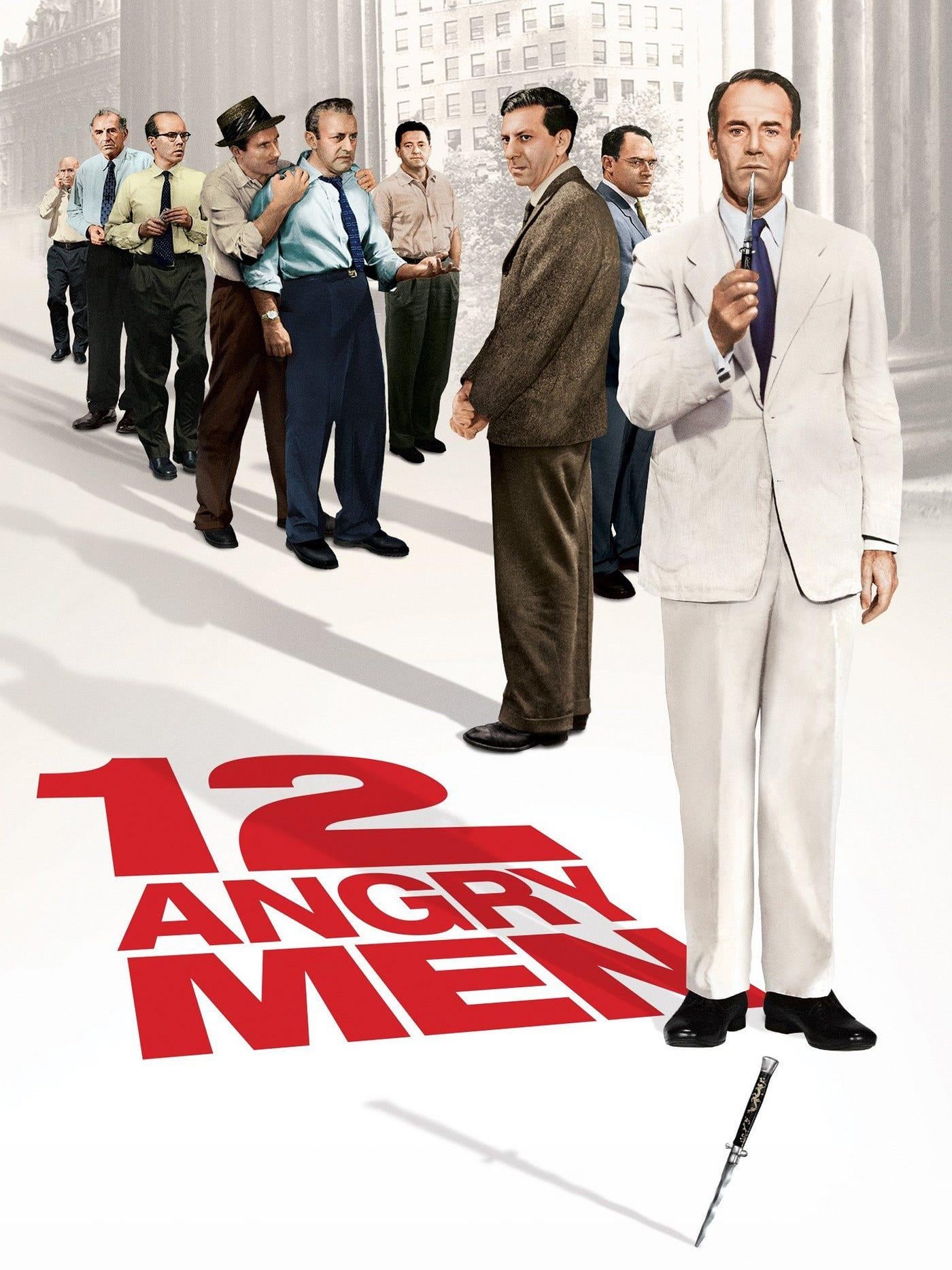 However, even though these obvious advantages were pointed out, the decision to actually move was anything but a no brainer. In fact, TAG president Eric Nemoto found himself to be the lone proponent. Years later he would liken the meeting that would ultimately decide TAG’s fate to be just like the Henry Fonda classic, “12 Angry Men.” In the movie, Fonda would be the sole juror in a murder trial who wants to “talk about” the case for which the rest of the 11 other jurors feel is, cut-and-dried, an obvious guilty verdict. And through analytical reasoning, he manages to eventually convince every juror that the defendent is not guilty. Similarly, at the onset of the meeting, Eric was the only board member – the rest being Frankie Enos, Ken Marcus, Laurie Tanoura, Brad Powell, Richard Tillotson, Keith Patterson, Rachel Heller – who wanted to move. But in that meeting, after Eric systematically listed all of the pro’s and very little, if at all, con’s, the other board members started to give it some thought. Brad, admittedly, said he could see both sides so essentially said he would support whatever the rest decided. Frankie was perhaps the greatest proponent of appreciating the ambiance that was Chinatown. But to this Eric reminded her of all the challenges that TAG had experienced at Mendonca. Was staying in Chinatown worth the aggravation? Eventually, Frankie acknowledged that it wasn’t. Richard, again, the man who first led TAG to Dole, was convinced to switch his vote after Eric’s line-by-line analysis. Ultimately, the turning point came when Eric convinced Laurie – who among everyone, was the person who always did most of the follow up work for TAG – by proclaiming that if the board would vote for the move, that he would “personally” move everything in the theater himself. That proclamation, Laurie would later say, sold it for her. She turned her vote from no to yes, the others would later follow suit, and the logical, yet still improbable move to The Shops at Dole Cannery, was going to be TAG’s new home. Like in the movie, Eric’s Henry Fonda arguments had worked.
However, even though these obvious advantages were pointed out, the decision to actually move was anything but a no brainer. In fact, TAG president Eric Nemoto found himself to be the lone proponent. Years later he would liken the meeting that would ultimately decide TAG’s fate to be just like the Henry Fonda classic, “12 Angry Men.” In the movie, Fonda would be the sole juror in a murder trial who wants to “talk about” the case for which the rest of the 11 other jurors feel is, cut-and-dried, an obvious guilty verdict. And through analytical reasoning, he manages to eventually convince every juror that the defendent is not guilty. Similarly, at the onset of the meeting, Eric was the only board member – the rest being Frankie Enos, Ken Marcus, Laurie Tanoura, Brad Powell, Richard Tillotson, Keith Patterson, Rachel Heller – who wanted to move. But in that meeting, after Eric systematically listed all of the pro’s and very little, if at all, con’s, the other board members started to give it some thought. Brad, admittedly, said he could see both sides so essentially said he would support whatever the rest decided. Frankie was perhaps the greatest proponent of appreciating the ambiance that was Chinatown. But to this Eric reminded her of all the challenges that TAG had experienced at Mendonca. Was staying in Chinatown worth the aggravation? Eventually, Frankie acknowledged that it wasn’t. Richard, again, the man who first led TAG to Dole, was convinced to switch his vote after Eric’s line-by-line analysis. Ultimately, the turning point came when Eric convinced Laurie – who among everyone, was the person who always did most of the follow up work for TAG – by proclaiming that if the board would vote for the move, that he would “personally” move everything in the theater himself. That proclamation, Laurie would later say, sold it for her. She turned her vote from no to yes, the others would later follow suit, and the logical, yet still improbable move to The Shops at Dole Cannery, was going to be TAG’s new home. Like in the movie, Eric’s Henry Fonda arguments had worked.
 The great TAG move to Dole took place on Sunday, July 25th, 2010. Prior to that from Monday, July 19th, 2010, through Saturday, July 24th, 2010, Eric Nemoto went on his personal crusade to move the theater by himself. Of course, in retrospect, no one truly expected that he could do so, and this is why the main move was scheduled for the 25th, but it didn’t deter him from moving as much as he could. In fact on each of those nights he would make three trips from Mendonca to Dole, transporting his filled up SUV with as much contents as he could stuff. This would be a gargantuan task, for each car load would require multiple trips from the Mendonca theater (using a filled-up flatbed cart), down the elevator, across the courtyard, and then along the sidewalk of Smith Street to get to his car, which sometimes might be an entire block away. The effort was good enough to impress Laurie Tanoura, who knew that Eric was fulfilling his promise because everyday she would open up the new theater and find another pile of theater stuff that Eric had unloaded the night before. Then, the great move on the 25th would attract a host of volunteers, the most preeminent being Allan Okubo and the University of Hawaii at Manoa fraternity, Kappa Epsilon Omicron, or, “KEO,” whose dozen members would prove to be invaluable as they worked like horses and did so for an incredibly affordable $500 (a steal really). It was Allan who had recommended KEO and this proved to be one of TAG’s best decisions ever. Eric and Andy Alvarado drove the large U-Haul truck that TAG had rented to and from Mendonca and Dole. Laurie led the volunteers at Dole on the receiving end, and Allan and KEO took care of getting things ready for pickup. In retrospect, the day went incredibly smooth, and by the late afternoon, the move was complete. A subsequent issue would arise after Mike Mazzola and Eric would later do a once through the Mendonca theater and clean things up, which included using Bondo, to patch a small hole in the wall. This latter development – the repaired hole and other things – would lead Mendonca to inform TAG that they intended to keep its deposit (one month’s rent), but this issue was settled by attorney and TAG board member, Ken Marcus, who wrote a stern letter that ultimately got TAG’s deposit back.
The great TAG move to Dole took place on Sunday, July 25th, 2010. Prior to that from Monday, July 19th, 2010, through Saturday, July 24th, 2010, Eric Nemoto went on his personal crusade to move the theater by himself. Of course, in retrospect, no one truly expected that he could do so, and this is why the main move was scheduled for the 25th, but it didn’t deter him from moving as much as he could. In fact on each of those nights he would make three trips from Mendonca to Dole, transporting his filled up SUV with as much contents as he could stuff. This would be a gargantuan task, for each car load would require multiple trips from the Mendonca theater (using a filled-up flatbed cart), down the elevator, across the courtyard, and then along the sidewalk of Smith Street to get to his car, which sometimes might be an entire block away. The effort was good enough to impress Laurie Tanoura, who knew that Eric was fulfilling his promise because everyday she would open up the new theater and find another pile of theater stuff that Eric had unloaded the night before. Then, the great move on the 25th would attract a host of volunteers, the most preeminent being Allan Okubo and the University of Hawaii at Manoa fraternity, Kappa Epsilon Omicron, or, “KEO,” whose dozen members would prove to be invaluable as they worked like horses and did so for an incredibly affordable $500 (a steal really). It was Allan who had recommended KEO and this proved to be one of TAG’s best decisions ever. Eric and Andy Alvarado drove the large U-Haul truck that TAG had rented to and from Mendonca and Dole. Laurie led the volunteers at Dole on the receiving end, and Allan and KEO took care of getting things ready for pickup. In retrospect, the day went incredibly smooth, and by the late afternoon, the move was complete. A subsequent issue would arise after Mike Mazzola and Eric would later do a once through the Mendonca theater and clean things up, which included using Bondo, to patch a small hole in the wall. This latter development – the repaired hole and other things – would lead Mendonca to inform TAG that they intended to keep its deposit (one month’s rent), but this issue was settled by attorney and TAG board member, Ken Marcus, who wrote a stern letter that ultimately got TAG’s deposit back.
The Star-Advertiser Article About TAG’s Big Move And “Duets”
 The great move to Dole, unbeknownst to many, was done under a cloud of worry. The site that TAG was moving to was not previously a theater. In fact, it was a retail store, Tuxedo Junction, and so, according to rules set by the City and County of Honolulu, a building permit was needed to renovate the space. Of course, this presented a terrible dilemma. Applying for a building permit, if TAG were to be forced to wait until an official permit were to be approved, could take months, if not years. This was absolutely not possible if TAG were to stay solvent and in existence. So the idea of pursuing the permit was one of TAG’s most serious and consequential decisions. What if the City said TAG couldn’t move in until the evaluation process was complete? What if TAG did move in, did its own renovation, but then was later found by the City to be in violation of the permitting process by not applying first? It could cause an inspector to shut down the theater. Hence, at that time, admittedly, the TAG Board seriously considered not making the effort. But Eric Nemoto was adamant, as the issue was not just about being approved as a theater. It had to do with the overall liability that TAG would incur had it NOT pursued getting a permit and eventually being officially approved as a theater. Anyone injured (for whatever reason) in the theater could sue the board, who held fiduciary responsibility for operating a safe site, and this could very well ruin TAG’s future, not to mention affect every board member personally. So, no, it was decided that TAG had to do it the right way. Still, when Eric Nemoto made the pilgrimage to the City’s Department of Planning and Permitting’s (DPP) “One Stop Servicing Center” (see photo top right) it was with great trepidation. Eric eventually talked to a DPP representative and explained TAG’s circumstances. He pleaded, “If we’re not doing a show immediately after moving in and bringing in revenue to pay for our overhead, we’re just not going to make it.” Amazingly enough, the representative acknowledged TAG’s situation, told Eric to continue with the permitting process as fast as possible. It seemed, at the time, that TAG’s future was set. But of course, this was only the start of a six-year odyssey to get the theater officially approved that would prove near maddening. But this, as they say, is another story.
The great move to Dole, unbeknownst to many, was done under a cloud of worry. The site that TAG was moving to was not previously a theater. In fact, it was a retail store, Tuxedo Junction, and so, according to rules set by the City and County of Honolulu, a building permit was needed to renovate the space. Of course, this presented a terrible dilemma. Applying for a building permit, if TAG were to be forced to wait until an official permit were to be approved, could take months, if not years. This was absolutely not possible if TAG were to stay solvent and in existence. So the idea of pursuing the permit was one of TAG’s most serious and consequential decisions. What if the City said TAG couldn’t move in until the evaluation process was complete? What if TAG did move in, did its own renovation, but then was later found by the City to be in violation of the permitting process by not applying first? It could cause an inspector to shut down the theater. Hence, at that time, admittedly, the TAG Board seriously considered not making the effort. But Eric Nemoto was adamant, as the issue was not just about being approved as a theater. It had to do with the overall liability that TAG would incur had it NOT pursued getting a permit and eventually being officially approved as a theater. Anyone injured (for whatever reason) in the theater could sue the board, who held fiduciary responsibility for operating a safe site, and this could very well ruin TAG’s future, not to mention affect every board member personally. So, no, it was decided that TAG had to do it the right way. Still, when Eric Nemoto made the pilgrimage to the City’s Department of Planning and Permitting’s (DPP) “One Stop Servicing Center” (see photo top right) it was with great trepidation. Eric eventually talked to a DPP representative and explained TAG’s circumstances. He pleaded, “If we’re not doing a show immediately after moving in and bringing in revenue to pay for our overhead, we’re just not going to make it.” Amazingly enough, the representative acknowledged TAG’s situation, told Eric to continue with the permitting process as fast as possible. It seemed, at the time, that TAG’s future was set. But of course, this was only the start of a six-year odyssey to get the theater officially approved that would prove near maddening. But this, as they say, is another story.Duets – The First Show In TAG’s Brand New Home
 When everyone associated with TAG looked around the theater on the eve of opening “Duets,” there had to be a sense of wonder. A mere three years earlier, TAG had been faced with the eventual closure of its long-time home (the building had been condemned) on Keawe Street in Kaka’ako, and was facing not only an uncertain future, but the very real prospect of folding, if no affordable new venue could be obtained. In fact, when TAG started the great push to find a new theater with the production of “From Penicillin to Po’okelas,” back in April of 2007, it literally had exactly zero funding for any possible move, and, morever, didn’t have even a clue as to where it could go. But here they were, a mere three years later, having first made the great move to Mendonca, in 2008, and then now the second – and even bigger – great move to Dole, looking to a brand new era. TAG had not only made this great move, but had finally found the ideal location. TAG had found what would become its perfect, permanent home.
When everyone associated with TAG looked around the theater on the eve of opening “Duets,” there had to be a sense of wonder. A mere three years earlier, TAG had been faced with the eventual closure of its long-time home (the building had been condemned) on Keawe Street in Kaka’ako, and was facing not only an uncertain future, but the very real prospect of folding, if no affordable new venue could be obtained. In fact, when TAG started the great push to find a new theater with the production of “From Penicillin to Po’okelas,” back in April of 2007, it literally had exactly zero funding for any possible move, and, morever, didn’t have even a clue as to where it could go. But here they were, a mere three years later, having first made the great move to Mendonca, in 2008, and then now the second – and even bigger – great move to Dole, looking to a brand new era. TAG had not only made this great move, but had finally found the ideal location. TAG had found what would become its perfect, permanent home.
 It was opening night, and merely the simple start to the play, “Duets,” but when actor Ron Heller (see photo right) walked onto the stage after the lights came on, he became the very first actor to appear in character on the new TAG stage at The Shops at Dole Cannery. While he had acted before, at the time, Ron was returning to theater after his son went away to college, and was actually more known for being one of Honolulu’s best lawyers (in 2025 he would be named Lawyer of the Year for Honolulu, Hawaii, in two categories: Tax Law and Litigation & Controversy – Tax, by The Best Lawyers in America®). But in time, Ron would appear in many plays, obtain his Master of Fine Arts degree in Theatre from the University of Hawaii at Manoa, and would go on to become one of TAG’s finest actors and directors.
It was opening night, and merely the simple start to the play, “Duets,” but when actor Ron Heller (see photo right) walked onto the stage after the lights came on, he became the very first actor to appear in character on the new TAG stage at The Shops at Dole Cannery. While he had acted before, at the time, Ron was returning to theater after his son went away to college, and was actually more known for being one of Honolulu’s best lawyers (in 2025 he would be named Lawyer of the Year for Honolulu, Hawaii, in two categories: Tax Law and Litigation & Controversy – Tax, by The Best Lawyers in America®). But in time, Ron would appear in many plays, obtain his Master of Fine Arts degree in Theatre from the University of Hawaii at Manoa, and would go on to become one of TAG’s finest actors and directors.
The Promotional Poster For “Duets”
 In Peter Quilter’s play, four very different and feisty mature age ‘couples’ find themselves in situations that could go any which way. Jonathon and Wendy are two singles on a blind date, feeling their way very gingerly. Janet reveals her feelings for her boss, Gary, whilst waiting for party guests to arrive. Shelly and Bobby go on holiday and arrive in their hotel room in Spain. Rather odd, considering that they only recently been granted a divorce! Angela is having last minute tremors as she is about to take wedding vows for the third time, and is having a heart to heart with her brother, Toby. Quilter’s writing, with more than a nod to Neil Simon, mixes together humour with pathos. Duets is an entertaining, and gentle night in the theatre. Creyton and Brown prove some 47 years after they first teamed up together at the old Phillip Street Theatre in What’s New?, that they are still a marvelous double act. They effortlessly change personas, assisted by different wigs, over the four scenes. Their continuing partnership with director Sandra Bates is again rewarding. Anna Ilic’s set works effectively with a large roof hanging over a changing living room, and to the left, hangs a picture frame with a different generic photo enclosed for each new location. (paraphrased from stagewhispers.com)
In Peter Quilter’s play, four very different and feisty mature age ‘couples’ find themselves in situations that could go any which way. Jonathon and Wendy are two singles on a blind date, feeling their way very gingerly. Janet reveals her feelings for her boss, Gary, whilst waiting for party guests to arrive. Shelly and Bobby go on holiday and arrive in their hotel room in Spain. Rather odd, considering that they only recently been granted a divorce! Angela is having last minute tremors as she is about to take wedding vows for the third time, and is having a heart to heart with her brother, Toby. Quilter’s writing, with more than a nod to Neil Simon, mixes together humour with pathos. Duets is an entertaining, and gentle night in the theatre. Creyton and Brown prove some 47 years after they first teamed up together at the old Phillip Street Theatre in What’s New?, that they are still a marvelous double act. They effortlessly change personas, assisted by different wigs, over the four scenes. Their continuing partnership with director Sandra Bates is again rewarding. Anna Ilic’s set works effectively with a large roof hanging over a changing living room, and to the left, hangs a picture frame with a different generic photo enclosed for each new location. (paraphrased from stagewhispers.com)
 To direct the very first production in TAG’s new home in The Shops at Dole Cannery was a tried and true veteran of the stage, particularly that of TAG’s stage. This was talented David Farmer (photo right, a director of many TAG plays). Helping him as his Assistant Director, was his wife, Loren Farmer. With them came eight truly outstanding actors. Ron Heller played Jonathan, Patrice Scott played Wendy, Richard Valasek played Barrie, Allyson West played Janet, John Whyte White played Bobby, Victoria Gail-White played Shelley, Peter Clark played Toby, and Karen Valasek played Angela. The crew included the usual supportive TAG team of specialists. Laurie Tanoura served in her usual capacity of Production Manager, Greg Howell handled Hair and Wigs, Carlynn Wolfe headed up Costume Design, and Thomas Tochiki created the Lighting Design, and also served as the Light and Sound Operator.
To direct the very first production in TAG’s new home in The Shops at Dole Cannery was a tried and true veteran of the stage, particularly that of TAG’s stage. This was talented David Farmer (photo right, a director of many TAG plays). Helping him as his Assistant Director, was his wife, Loren Farmer. With them came eight truly outstanding actors. Ron Heller played Jonathan, Patrice Scott played Wendy, Richard Valasek played Barrie, Allyson West played Janet, John Whyte White played Bobby, Victoria Gail-White played Shelley, Peter Clark played Toby, and Karen Valasek played Angela. The crew included the usual supportive TAG team of specialists. Laurie Tanoura served in her usual capacity of Production Manager, Greg Howell handled Hair and Wigs, Carlynn Wolfe headed up Costume Design, and Thomas Tochiki created the Lighting Design, and also served as the Light and Sound Operator.
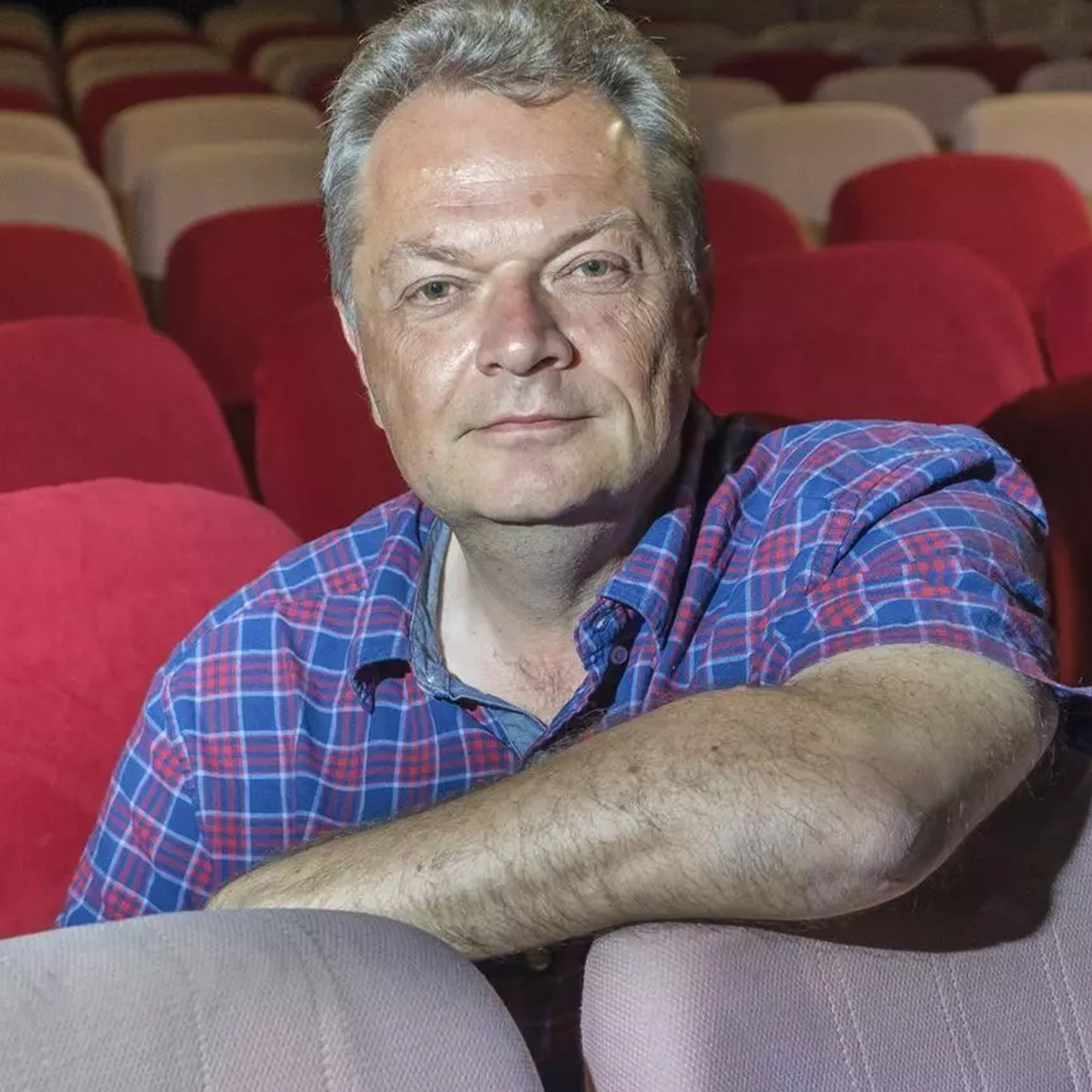 Peter Quilter’s plays have been produced in over 40 countries around the world and translated into 30 languages. He has had three successful shows in London’s West End, a hit run on Broadway and has twice been nominated for the Olivier Award – for Best New Play and Best New Comedy. His first international success was the comedy, “Glorious!” – the true story of Florence Foster Jenkins, the worst singer in the world. The play premiered at the Duchess Theatre in London’s West End and has since been seen by over two million people in theatres across five continents. His Judy Garland musical-drama “End of the Rainbow” had its world premiere at the Sydney Opera House in Australia. The show then played a sold-out run in London’s West End before transferring to Broadway in 2012, where the production received nominations for three Tony Awards. In 2019, the play was adapted for the Oscar-winning film, “Judy,” starring Renee Zellweger. Peter’s two-actor comedy, “Duets,” has been performed in 20 countries since its premiere production in Sydney. The popular French production (titled “Face à Face”) was broadcasted “live” on television in Paris and the show also played in Russia, Hungary, Romania, Sweden and Brazil. His other plays include the drama, “4000 Days,” which has been produced in Prague, Hamburg, Aachen, Sao Paulo, Warsaw and the USA since its London debut in 2016. Peter also has had success with several additional comedies, “The Actress” (which had a run at the National Theatre in Sofia), the 3-actor, “Bestseller” (which premiered at the International City Theatre in Los Angeles), and “The Hill” (which had its first productions in Prague and Poland in 2020). Other works include the pop musical, “Boyband,” which played a season in London’s West End, had runs in Warsaw and Amsterdam, and has been on stage in Bratislava. (theartbassador.gr)
Peter Quilter’s plays have been produced in over 40 countries around the world and translated into 30 languages. He has had three successful shows in London’s West End, a hit run on Broadway and has twice been nominated for the Olivier Award – for Best New Play and Best New Comedy. His first international success was the comedy, “Glorious!” – the true story of Florence Foster Jenkins, the worst singer in the world. The play premiered at the Duchess Theatre in London’s West End and has since been seen by over two million people in theatres across five continents. His Judy Garland musical-drama “End of the Rainbow” had its world premiere at the Sydney Opera House in Australia. The show then played a sold-out run in London’s West End before transferring to Broadway in 2012, where the production received nominations for three Tony Awards. In 2019, the play was adapted for the Oscar-winning film, “Judy,” starring Renee Zellweger. Peter’s two-actor comedy, “Duets,” has been performed in 20 countries since its premiere production in Sydney. The popular French production (titled “Face à Face”) was broadcasted “live” on television in Paris and the show also played in Russia, Hungary, Romania, Sweden and Brazil. His other plays include the drama, “4000 Days,” which has been produced in Prague, Hamburg, Aachen, Sao Paulo, Warsaw and the USA since its London debut in 2016. Peter also has had success with several additional comedies, “The Actress” (which had a run at the National Theatre in Sofia), the 3-actor, “Bestseller” (which premiered at the International City Theatre in Los Angeles), and “The Hill” (which had its first productions in Prague and Poland in 2020). Other works include the pop musical, “Boyband,” which played a season in London’s West End, had runs in Warsaw and Amsterdam, and has been on stage in Bratislava. (theartbassador.gr)
The Honolulu Star-Advertiser Review Of “Duets”
“Duets” opened TAG to its brand new era in The Shops of Dole Cannery, on Friday, August 27th, 2010, at 7:30 p.m. Its second show was on the following night, Saturday, August 28th, also at 7:30 p.m. A Sunday matinee followed on August 29th, at 2:00 p.m. The run continued for three more weeks, again, at 7:30 p.m. for Thursday through Saturday night performances, and at 2:00 p.m. for Sunday matinees. “Duets” closed on Sunday, September 19th, 2010. All told, the production played for 15 shows before very consistent and appreciative audiences.
The Promotional Postcard For “Duets”
Ghosts – Brad Powell Translates A Personal Favorite
 Paraphrased From ‘The Director’s Note’ Of The “Ghosts” Program: When Brad Powell (see photo left) was a teenager, he was blessed to live in Norway for three years. Because of this he fell in love with the country and the people, and came to appreciate the plays of Henrik Ibsen, the music of Edvard Grieg, the paintings of Edvard Munch, and the amazing sculpture work of Gustav Vigeland. Some years later, as a television producer in Hawaii, he created a series, Hand-In-Hand, dealing with parenting and the relationships between men and women and their children. With grants from the Hawaii State Foundation on Culture and The Arts, and Pan American Airways, he was able to return to Norway, and make a documentary, Images, about the works and life of Vigeland. His statues are found all together in a beautiful park in the middle of Norway’s capital city, Oslo. His statues deal with the powerful forces that draw men and women together and tear them apart. The series, Hand-In-Hand, received the Gold Medal Award and the film, Images (shown in its entirety below), received a Bronze medal at the 1977 New York Film & TV Festival.
Paraphrased From ‘The Director’s Note’ Of The “Ghosts” Program: When Brad Powell (see photo left) was a teenager, he was blessed to live in Norway for three years. Because of this he fell in love with the country and the people, and came to appreciate the plays of Henrik Ibsen, the music of Edvard Grieg, the paintings of Edvard Munch, and the amazing sculpture work of Gustav Vigeland. Some years later, as a television producer in Hawaii, he created a series, Hand-In-Hand, dealing with parenting and the relationships between men and women and their children. With grants from the Hawaii State Foundation on Culture and The Arts, and Pan American Airways, he was able to return to Norway, and make a documentary, Images, about the works and life of Vigeland. His statues are found all together in a beautiful park in the middle of Norway’s capital city, Oslo. His statues deal with the powerful forces that draw men and women together and tear them apart. The series, Hand-In-Hand, received the Gold Medal Award and the film, Images (shown in its entirety below), received a Bronze medal at the 1977 New York Film & TV Festival.
“Images” – Brad Powell’s Excellent Documentary On The Life And Works Of Gustav Vigeland
Since that time Brad had longed to direct an Ibsen play and share his love with Norway to others. It was not until 2010 that his dream became a reality. He decided to translate Ghosts, which proved to be one of the most taxing, yet enjoyable, experiences of his life. To appreciate the challenge confronting Brad, it must be understood that he had to first translate the original script that was in Danish, into Norwegian, and then subsequently translate it from Norwegian into English. Let that process filter through our collective minds. It was indeed a Herculean effort, as significant a creative accomplishment as any attained in the history of TAG. And so, it was Ghosts, as translated by Brad, which became the next play up in TAG’s 2010-2011 season, and with it, to also celebrate the four great artists of Norway – Ibsen, Grieg, Munch, and Vigeland.
The Playbill For “Ghosts”
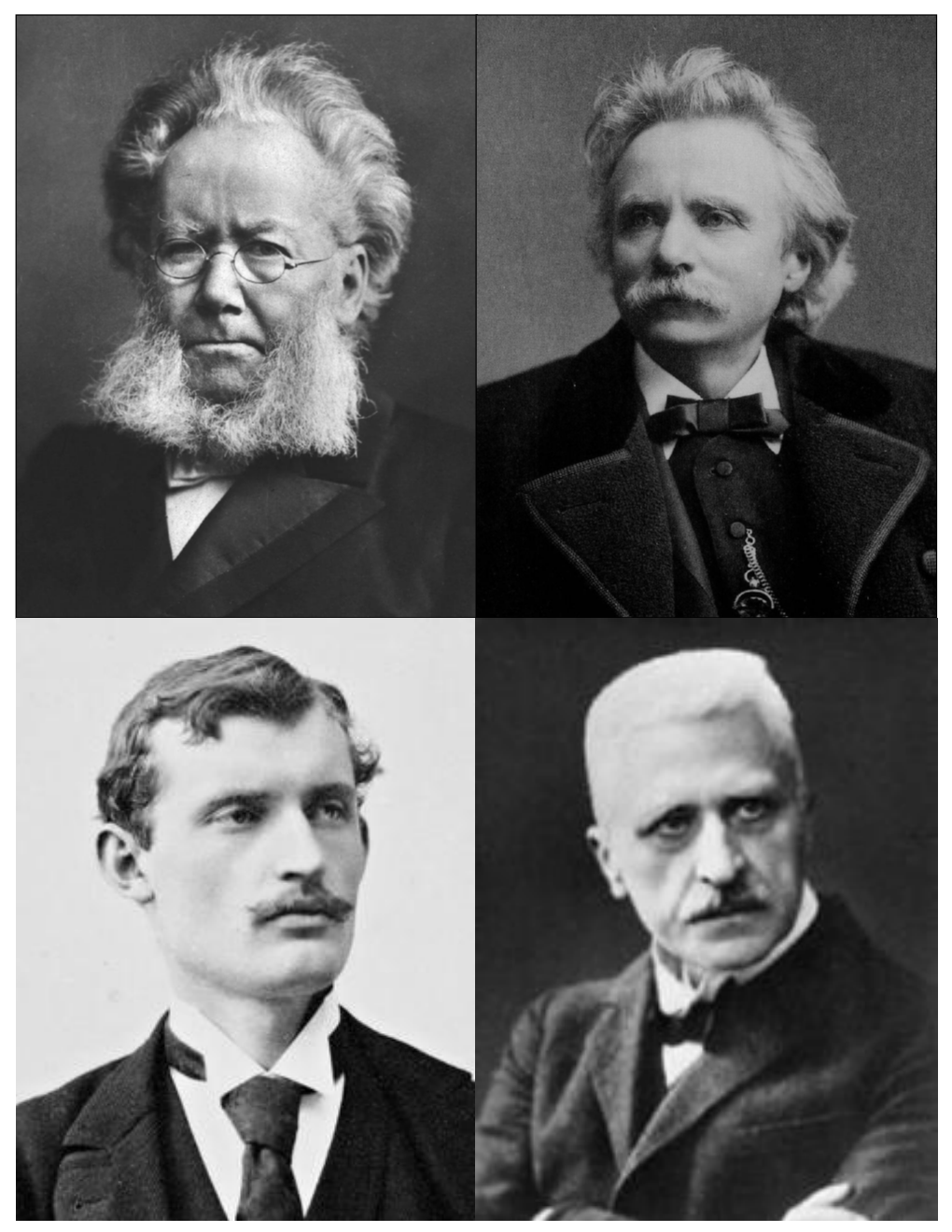 Four Creative Norway Geniuses (from the playbill of Ghosts): ♦ Often referred to as “the father” of modern drama, Henrik Ibsen (top left of photo montage) is one of the founders of Modernism in the theatre. His plays were considered scandalous to many of his era, when European theatre was required to model strict mores of family life and propriety. Ibsen’s work examined the realities that lay behind many facades, revealing much that was disquieting to a critical eye and free inquiry issues of morality. Ibsen is often ranked as one of the truly great playwrights in the European tradition, alongside Shakespeare. Ibsen’s most noted work includes Ghosts, A Doll’s House, Hedda Gabbler, and Enemy Of The People. In addition to being a playwright, he was also a theatre director and a poet. Grieg wrote the music for Ibsen’s plays, Munch designed the set for Ghosts, and Vigeland sculpted a bust of Ibsen. ♦ Edvard Grieg (top right of the photo montage) was a Norwegian composer and pianist who composed in the Romantic period. He is best known for his Piano Concerto in A minor, for his incidental music to Henrik Ibsen’s play Peer Gynt (which includes Morning Mood and In The Hall Of The Mountain King), and for his collection of piano miniatures. Vigeland also sculpted a bust of Grieg. ♦ Here is a quote from Edvard Munch (bottom left of the photo montage), the Norwegian painter best known for the painting, The Scream, which was inspired by his sister’s death from tuberculosis. “At different moments you see with different eyes. You see differently in the morning than you do in the evening. In addition, how you see is also dependent on your emotional state. Because of this, a motif can be seen in many different ways, and this is what makes art interesting.” Munch designed the set for Ibsen’s play, Ghosts. ♦ In 1921, after a long dispute, the City of Oslo granted Gustav Vigeland (bottom right of the photo montage) a building where he could work and live. In exchange, he promised to donate to the city all his subsequent works, including sculptures, drawings, engravings, and models. It was located in the vicinity of Frogner Park, which he had chosen as the definitive location for his fountain. Over the following 20 years, Vigeland was devoted to the project of an open exhibition of his works which later turned into what is universally known as Vigeland Park. The park covers 80 acres and features 212 bronze and granite sculptures designed by Gustave Vigeland. The sculptures culminate in the famous Monolith (Monolitten), with its 121 figures struggling to reach the top of the sculpture. There is a statue of Vigeland in front of the Norwegian National Museum.
Four Creative Norway Geniuses (from the playbill of Ghosts): ♦ Often referred to as “the father” of modern drama, Henrik Ibsen (top left of photo montage) is one of the founders of Modernism in the theatre. His plays were considered scandalous to many of his era, when European theatre was required to model strict mores of family life and propriety. Ibsen’s work examined the realities that lay behind many facades, revealing much that was disquieting to a critical eye and free inquiry issues of morality. Ibsen is often ranked as one of the truly great playwrights in the European tradition, alongside Shakespeare. Ibsen’s most noted work includes Ghosts, A Doll’s House, Hedda Gabbler, and Enemy Of The People. In addition to being a playwright, he was also a theatre director and a poet. Grieg wrote the music for Ibsen’s plays, Munch designed the set for Ghosts, and Vigeland sculpted a bust of Ibsen. ♦ Edvard Grieg (top right of the photo montage) was a Norwegian composer and pianist who composed in the Romantic period. He is best known for his Piano Concerto in A minor, for his incidental music to Henrik Ibsen’s play Peer Gynt (which includes Morning Mood and In The Hall Of The Mountain King), and for his collection of piano miniatures. Vigeland also sculpted a bust of Grieg. ♦ Here is a quote from Edvard Munch (bottom left of the photo montage), the Norwegian painter best known for the painting, The Scream, which was inspired by his sister’s death from tuberculosis. “At different moments you see with different eyes. You see differently in the morning than you do in the evening. In addition, how you see is also dependent on your emotional state. Because of this, a motif can be seen in many different ways, and this is what makes art interesting.” Munch designed the set for Ibsen’s play, Ghosts. ♦ In 1921, after a long dispute, the City of Oslo granted Gustav Vigeland (bottom right of the photo montage) a building where he could work and live. In exchange, he promised to donate to the city all his subsequent works, including sculptures, drawings, engravings, and models. It was located in the vicinity of Frogner Park, which he had chosen as the definitive location for his fountain. Over the following 20 years, Vigeland was devoted to the project of an open exhibition of his works which later turned into what is universally known as Vigeland Park. The park covers 80 acres and features 212 bronze and granite sculptures designed by Gustave Vigeland. The sculptures culminate in the famous Monolith (Monolitten), with its 121 figures struggling to reach the top of the sculpture. There is a statue of Vigeland in front of the Norwegian National Museum.
Osvald Alving (Mathias Maas) & Helene Alving (Frankie Enos) discuss the legacy of her husband in “Ghosts”
Norwegian Words That Were Inserted Into The Program For “Ghosts”
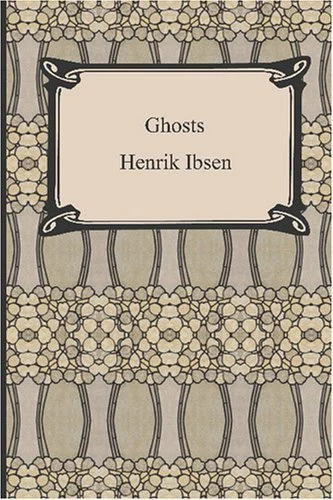 Mrs. Alving’s world crumbles when her son’s illness reveals the devastating consequences of her past and forces her to confront the ghosts of her late husband’s immoral life. She is building an orphanage as a memorial to her husband. This edifice is to be dedicated the next day, and her old friend Parson Manders has come to perform the ceremonies. In a private conversation, Mrs. Alving tells the Parson that her husband had been a complete degenerate, and she is using the rest of his money to build the orphanage so that she can leave only her money to her son Oswald, who has just arrived home from years and years abroad. In a private talk with his mother, Oswald confesses that he has an incurable disease which the doctors think was inherited. Oswald, however, believes his father to have been a perfect man. Mrs. Alving, then, must confess that Mr. Alving had indeed been a degenerated man and that Oswald caught the disease from his father. Oswald knows that he is dying and wants to take the maid as his mistress so that the maid, Regina, will give him poison when he is next struck by the disease. Mrs. Alving then explains that Regina is in reality his half sister. This does not bother Oswald, but Regina refuses to stay. Oswald then tells his mother that she must administer the medicine when the next attack comes. As the play closes, Oswald begins to have his attack and his mother does not know whether to administer the poison or to endure the agony. (cliffsnotes.com)
Mrs. Alving’s world crumbles when her son’s illness reveals the devastating consequences of her past and forces her to confront the ghosts of her late husband’s immoral life. She is building an orphanage as a memorial to her husband. This edifice is to be dedicated the next day, and her old friend Parson Manders has come to perform the ceremonies. In a private conversation, Mrs. Alving tells the Parson that her husband had been a complete degenerate, and she is using the rest of his money to build the orphanage so that she can leave only her money to her son Oswald, who has just arrived home from years and years abroad. In a private talk with his mother, Oswald confesses that he has an incurable disease which the doctors think was inherited. Oswald, however, believes his father to have been a perfect man. Mrs. Alving, then, must confess that Mr. Alving had indeed been a degenerated man and that Oswald caught the disease from his father. Oswald knows that he is dying and wants to take the maid as his mistress so that the maid, Regina, will give him poison when he is next struck by the disease. Mrs. Alving then explains that Regina is in reality his half sister. This does not bother Oswald, but Regina refuses to stay. Oswald then tells his mother that she must administer the medicine when the next attack comes. As the play closes, Oswald begins to have his attack and his mother does not know whether to administer the poison or to endure the agony. (cliffsnotes.com)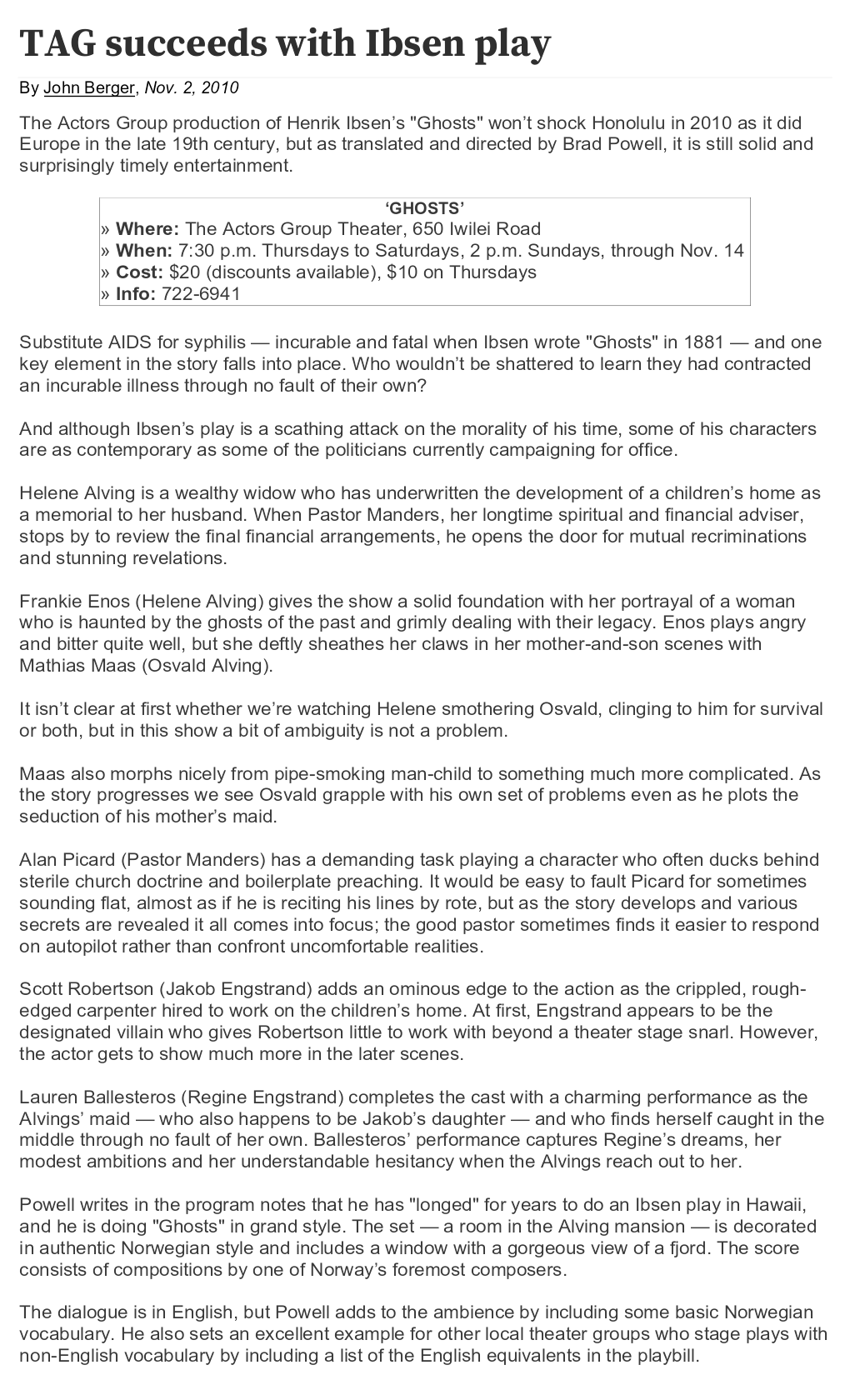 The Honolulu Star-Advertiser Review Of “Ghosts”
The Honolulu Star-Advertiser Review Of “Ghosts”
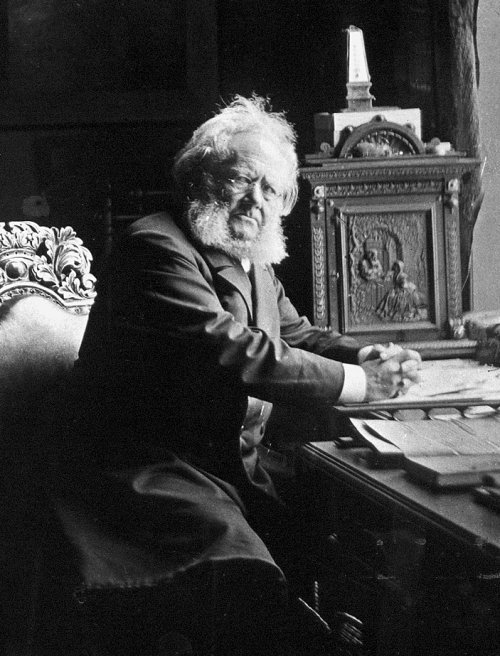 In the 19th century, the playwright Henrik Ibsen (see photo left) completely rewrote the rules of drama by introducing a form of realism that we still see in theatres today. He turned the European stage away from what it had become – a plaything and distraction for the bored – and introduced a new type of moral analysis. Ibsen brought his audience into ordinary people’s drawing rooms, where the bourgeois kept their carefully guarded secrets. He then pitted the conflicts that arose from challenging assumptions and direct confrontations against a very realistic middle-class background and developed his plays with piercing dialogue and meticulous attention to detail. For this, he has earned his place in history. Ibsen is undoubtedly one of the greatest playwrights in the universe. So naturally, The International Astronomical Union named a planet after him. Only a minor planet, but still! Henrik Ibsen’s major works include “Brand,” “Peer,” “An Enemy of the People,” and “A Doll’s House,” as well as “Hedda Gabler,” “Ghosts,” “The Wild Duck,” “When We Dead Awaken,” and “The Master Builder.” All of these plays have strong and challenging characters that live on in the audience’s imagination outside of their plays’ intrigues. “A Doll’s House” is perhaps the most-staged of Ibsen’s plays. The third act culminates in the character of Nora leaving her husband Torvald and her three children – unheard of in 1879, when it was first performed, and still one of the most famous gender political moments in world literature. The role of Nora even holds an iconic status: UNESCO’s Memory of the World register calls Nora “a symbol throughout the world, for women fighting for liberation and equality.” (visitnorway.com)
In the 19th century, the playwright Henrik Ibsen (see photo left) completely rewrote the rules of drama by introducing a form of realism that we still see in theatres today. He turned the European stage away from what it had become – a plaything and distraction for the bored – and introduced a new type of moral analysis. Ibsen brought his audience into ordinary people’s drawing rooms, where the bourgeois kept their carefully guarded secrets. He then pitted the conflicts that arose from challenging assumptions and direct confrontations against a very realistic middle-class background and developed his plays with piercing dialogue and meticulous attention to detail. For this, he has earned his place in history. Ibsen is undoubtedly one of the greatest playwrights in the universe. So naturally, The International Astronomical Union named a planet after him. Only a minor planet, but still! Henrik Ibsen’s major works include “Brand,” “Peer,” “An Enemy of the People,” and “A Doll’s House,” as well as “Hedda Gabler,” “Ghosts,” “The Wild Duck,” “When We Dead Awaken,” and “The Master Builder.” All of these plays have strong and challenging characters that live on in the audience’s imagination outside of their plays’ intrigues. “A Doll’s House” is perhaps the most-staged of Ibsen’s plays. The third act culminates in the character of Nora leaving her husband Torvald and her three children – unheard of in 1879, when it was first performed, and still one of the most famous gender political moments in world literature. The role of Nora even holds an iconic status: UNESCO’s Memory of the World register calls Nora “a symbol throughout the world, for women fighting for liberation and equality.” (visitnorway.com)
Ghosts had a very popular run. It opened on Friday, October 22nd, 2010. After its opening weekend it played for Thursday through Saturday nights at 7:30 p.m. and Sunday matinees at 2:00 p.m. It closed on Sunday, November 14th, 2010, and in all, played for 15 performances. Director Brad Powell had the great advantage of having cast a group of stellar actors. These included (characters in parentheses): Frankie Enos (Fru Helen Alving); Mathias Maas (Osvald Alving); Alan Picard (Pastor Manders); Scott Robertson (Jakob Engstrand); and Lauren Ballesteros (Regina Engstrand). Brad’s great crew consisted of Denise-Aiko Chinen serving as his Assistant Director, Mikie Fambro as his Universal Assistant, Mary Ann Shirley Gray was the Stage Manager, Andy Alvarado was in charge of Set Design, Construction and Dressing (for which Brad assisted in the Set Design and its Construction), Brad created the Sound Design, Thomas Tochiki created the Light Design and then served as the production’s Light and Sound Operator, Carlynn Wolfe coordinated the Costume Design, Greg Howell handled the Hair and Wig Design, Jason Taglianetti took care of the Photography, and Joyce Powell manned the Box Office. Laurie Tanoura served in her usual capacity as TAG’s Production Manager. Special Thanks was accorded to Manoa Valley Theatre for set pieces, Kumu Kahua Theatre for lights, the University of Hawaii at Manoa for the sofa that was used on the set, Chris Valles for assisting with costumes, and Mara Miller and Scott Robertson for the rosemaling on the set.
The Postcard For “Ghosts”
Merry Christmas, Roberta – A Chinatown Story Not Done In Chinatown
 It was just a passing moment during the middle of a fateful phone call. Eric Nemoto, President of TAG, had called Ernie Hunt, TAG’s landlord when they were at the Mendonca Building, and informed him that TAG’s Board of Directors had voted that the theater would be moving to The Shops At Dole Cannery and so he would not be signing another lease. There must’ve been an air of certainty in Eric’s voice at the time, for Ernie’s immediate response was to say, “That’s too bad, is there anything that can we can do to keep you?” Eric responded, no, that it was a done deal, for he had already signed Dole’s lease, and TAG’s move was already being planned. It was the first time that Ernie seemed to let on about being disappointed. Prior to that his tonality during lease discussions with Eric was always that of a negotiator who held all the cards. But upon finally accepting the fate that his unique artists community would be losing one of Hawaii’s best community theaters, he lamented, “It’s unfortunate that we won’t get to see, ‘Merry Christmas, Roberta,’ done in Chinatown.” NOTE: The photo used for the play postcard (see inset image), the cover of the playbill (see below), as well as other promotional material, was taken in front of the old Yellow Brick Studio on Keawe Street, the original stomping grounds of TAG – The Actors’ Group, even though the theater had long since moved from that location for over two years.
It was just a passing moment during the middle of a fateful phone call. Eric Nemoto, President of TAG, had called Ernie Hunt, TAG’s landlord when they were at the Mendonca Building, and informed him that TAG’s Board of Directors had voted that the theater would be moving to The Shops At Dole Cannery and so he would not be signing another lease. There must’ve been an air of certainty in Eric’s voice at the time, for Ernie’s immediate response was to say, “That’s too bad, is there anything that can we can do to keep you?” Eric responded, no, that it was a done deal, for he had already signed Dole’s lease, and TAG’s move was already being planned. It was the first time that Ernie seemed to let on about being disappointed. Prior to that his tonality during lease discussions with Eric was always that of a negotiator who held all the cards. But upon finally accepting the fate that his unique artists community would be losing one of Hawaii’s best community theaters, he lamented, “It’s unfortunate that we won’t get to see, ‘Merry Christmas, Roberta,’ done in Chinatown.” NOTE: The photo used for the play postcard (see inset image), the cover of the playbill (see below), as well as other promotional material, was taken in front of the old Yellow Brick Studio on Keawe Street, the original stomping grounds of TAG – The Actors’ Group, even though the theater had long since moved from that location for over two years.
The Playbill For The Reprise Of “Merry Christmas, Roberta”
TAG’s next production would be a reprise of the surprise 2007-2008 hit of the same name, “Merry Christmas, Roberta.” The original production had come out of nowhere to win one of the Best Play awards at the 2008 Po’okelas, and coupled with its natural advantage of appealing to a Christmas period audience (always a theater risk to stage a production during the holiday season) since that is when the play occurs, Artistic Director Brad Powell, believed, after three years, that it would be a good pick to now stage it in TAG’s new theater. His belief would prove to be spot on. For more information on the history of “Roberta” see the original production listed in the 2007-2008 season.
The Promotional Postcard For The IHS Benefit Performance Of “Merry Christmas, Roberta”
 Though it was a reprise, there were a number of differences in this version of Roberta as compared to the original. First, Jon Brekke would return as director, but solely this time. Michael Wurth, who had co-directed the original version with Jon, had since moved to Texas, and so Jon took on the directorial reins by himself. And while Laurie Tanoura, Eric Nemoto, and Charlotte Dias would return for their respective roles (Eric as Alvin Amino, Laurie as Roberta – which had won her a Po’okela award for her acting excellence – and Charlotte Dias as Mrs. Ketler), the rest of the roles would be cast with new actors. Young Brandi Taylor was cast as Lynette Amino, experienced and talented Maile Holck (see inset photo left) was cast as Nora Amino, Alvin’s wife and Lynette’s mother, Mark Malalis took over the role of the store hand Ben, and Tracy Hanayo Okubo took on the dual role of Candace the street urchin drug addict and Paula Beckman, Lynette’s concerned teacher. Changes to some of the characters were also made by Jon. Charlotte Dias’ character of Mrs. Ketler was changed to Mrs. Delacruz, and more of an emphasis to showcase Maile (who would become an equity actor with the Honolulu Theatre for Youth). In specific, the scene where in the original version Alvin revisits Roberta and learns the details about Roberta’s past, would be changed to Nora being the character that goes over to talk to Roberta. This was a great change to the storyline which essentially focused the play equally onto Nora, and Maile handled the increase of the role flawlessly. Lastly, as the central core of the play is about Roberta, a homeless woman, Jon arranged with Connie Mitchell, the Executive Director of The Institute for Human Services, Inc. (IHS), to have a benefit night for the organization which serves Honolulu’s homeless population. As such, TAG agreed to dedicate one night, December 16th, 2010, a preview just prior to opening night, to be the performance wherein the proceeds would go solely to IHS. This would prove to be immensely successful, as the following letter of appreciation would confirm.
Though it was a reprise, there were a number of differences in this version of Roberta as compared to the original. First, Jon Brekke would return as director, but solely this time. Michael Wurth, who had co-directed the original version with Jon, had since moved to Texas, and so Jon took on the directorial reins by himself. And while Laurie Tanoura, Eric Nemoto, and Charlotte Dias would return for their respective roles (Eric as Alvin Amino, Laurie as Roberta – which had won her a Po’okela award for her acting excellence – and Charlotte Dias as Mrs. Ketler), the rest of the roles would be cast with new actors. Young Brandi Taylor was cast as Lynette Amino, experienced and talented Maile Holck (see inset photo left) was cast as Nora Amino, Alvin’s wife and Lynette’s mother, Mark Malalis took over the role of the store hand Ben, and Tracy Hanayo Okubo took on the dual role of Candace the street urchin drug addict and Paula Beckman, Lynette’s concerned teacher. Changes to some of the characters were also made by Jon. Charlotte Dias’ character of Mrs. Ketler was changed to Mrs. Delacruz, and more of an emphasis to showcase Maile (who would become an equity actor with the Honolulu Theatre for Youth). In specific, the scene where in the original version Alvin revisits Roberta and learns the details about Roberta’s past, would be changed to Nora being the character that goes over to talk to Roberta. This was a great change to the storyline which essentially focused the play equally onto Nora, and Maile handled the increase of the role flawlessly. Lastly, as the central core of the play is about Roberta, a homeless woman, Jon arranged with Connie Mitchell, the Executive Director of The Institute for Human Services, Inc. (IHS), to have a benefit night for the organization which serves Honolulu’s homeless population. As such, TAG agreed to dedicate one night, December 16th, 2010, a preview just prior to opening night, to be the performance wherein the proceeds would go solely to IHS. This would prove to be immensely successful, as the following letter of appreciation would confirm.
Connie Mitchell’s Letter Of Thanks For TAG’s Support Of IHS
“Merry Christmas, Roberta” attained solid audiences through its entire run. It opened on Friday, December 17th, 2010, and on Saturday and Sunday of that first weekend, and then continued for three more weeks, playing on Thursday through Saturday nights at 7:30 p.m., and two shows on Sundays at 2:00 p.m. and 5:30 p.m. It played for a total of 19 performances and closed on the second show of Sunday, January 9th 2011. The crew that worked this production included (roles and/or responsibilities are in parentheses): Andy Alvarado (Set Design & Construction); Jon Brekke (Sound Design); Thomas Tochiki (Lighting Design, Light & Sound Operator); Carlynn Wolfe (Costume Design); Greg Howell (Hair & Wig Design); Jason Taglianetti (Photography); Laurie Tanoura (Publicity, Program & Web Design); and Joyce Powell (Reservations & Door). Laurie Tanoura, in addition to starring in the play, also served as the Production Manager. Special Thanks were accorded to Oceanic Cable for the airing of the play’s PSA, City Mill for the loaning of the shopping cart seen on stage, and the following for donating food for the set (which was subsequently donated to IHS) – Charlotte Dias, Alan Picard, Frankie Enos, Eric & Mary Ann Nemoto, Eden-Lee Murray, Mara Miller & Scott Robertson, and Linda Mitchell.
The Honolulu Star-Advertiser’s John Berger’s “On The Scene” Write-Up About “Merry Christmas, Roberta”
The Reprise Of The Play, “Merry Christmas, Roberta,” In Its Entirety
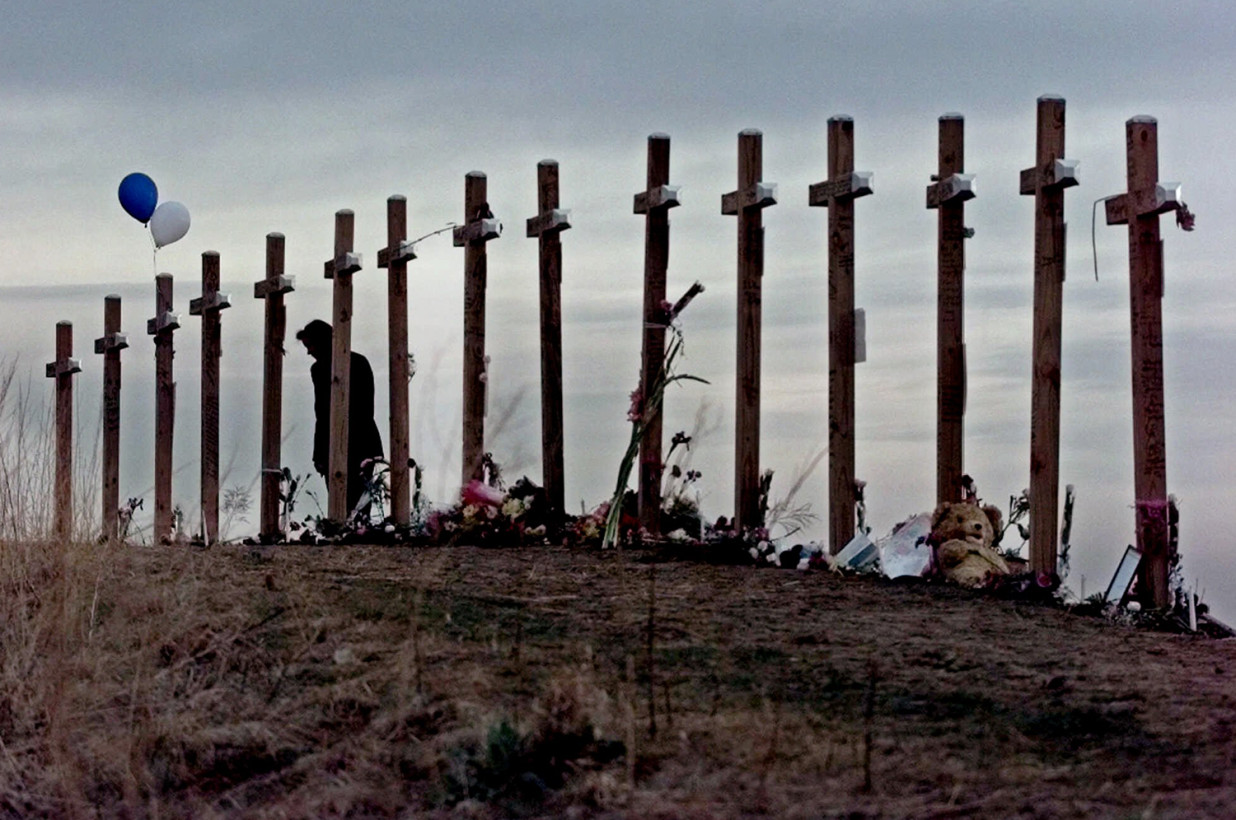 The surreal backstory of “Roberta:” Was it just a macabre coincidence? Or was it a mysterious case of life imitating art? To this day, it is something to wonder about. In the very first original screenplay that Eric Nemoto wrote based on Jon Brekke’s original story concept, Eric had to come up with a reason for why Roberta became homeless. He chose as a reason her daughter being massacred in a high school shooting and then the suicide of her husband who could not get over their loss. But there was an “eeriness” in choosing this plot point simply because of the surreal circumstance that Eric completed the very first draft of “Merry Christmas, Roberta” well before the infamous school massacre of Columbine High School, which happened on April 20th, 1999. In fact, the second (and near final) draft of the script (with the shooting angle) was finalized a week before on April 13th, 1999. It made for chilling conversations between Eric and Jon as Columbine exploded onto the American psyche and came to dominate the television airwaves.
The surreal backstory of “Roberta:” Was it just a macabre coincidence? Or was it a mysterious case of life imitating art? To this day, it is something to wonder about. In the very first original screenplay that Eric Nemoto wrote based on Jon Brekke’s original story concept, Eric had to come up with a reason for why Roberta became homeless. He chose as a reason her daughter being massacred in a high school shooting and then the suicide of her husband who could not get over their loss. But there was an “eeriness” in choosing this plot point simply because of the surreal circumstance that Eric completed the very first draft of “Merry Christmas, Roberta” well before the infamous school massacre of Columbine High School, which happened on April 20th, 1999. In fact, the second (and near final) draft of the script (with the shooting angle) was finalized a week before on April 13th, 1999. It made for chilling conversations between Eric and Jon as Columbine exploded onto the American psyche and came to dominate the television airwaves.
Gem Of The Ocean – August Wilson’s First Play Of His Pittsburg Cycle
 TAG’s next production was to return to another August Wilson (photo left) play, “Gem Of The Ocean,” for its now tradition of producing an African American play over the Martin Luther King Holiday. Wilson has been referred to as the “theater’s poet of Black America,” who was best known for a series of 10 plays, collectively called The Pittsburgh Cycle (or The Century Cycle), which chronicle the experiences and heritage of the African-American community in the 20th century. And while each of Wilson’s plays were unique and powerful in their own ways, there had to be a first, and this was “Gem Of The Ocean.” TAG had already produced five of Wilson’s plays, “Two Trains Running,” “Joe Turner’s Come And Gone,” “Jitney,” “Fences,”
TAG’s next production was to return to another August Wilson (photo left) play, “Gem Of The Ocean,” for its now tradition of producing an African American play over the Martin Luther King Holiday. Wilson has been referred to as the “theater’s poet of Black America,” who was best known for a series of 10 plays, collectively called The Pittsburgh Cycle (or The Century Cycle), which chronicle the experiences and heritage of the African-American community in the 20th century. And while each of Wilson’s plays were unique and powerful in their own ways, there had to be a first, and this was “Gem Of The Ocean.” TAG had already produced five of Wilson’s plays, “Two Trains Running,” “Joe Turner’s Come And Gone,” “Jitney,” “Fences,” and “The Piano Lesson.” So “Gem” was now venturing onto the remainder of Wilson’s Pittsburgh Cycle, and for sure by this time, ingrained into TAG (particularly its Artistic Director, Brad Powell) to one day become one of just a handful of theaters across the country to produce all 10 of Wilson’s plays. To direct this latest Wilson edition, Brad got Russell Motter (photo right), already a proven Wilson play director (“Joe Turner’s Come And Gone” in 2006), to once again lend his steady, talented hand towards bringing “Gem” to TAG’s stage.
and “The Piano Lesson.” So “Gem” was now venturing onto the remainder of Wilson’s Pittsburgh Cycle, and for sure by this time, ingrained into TAG (particularly its Artistic Director, Brad Powell) to one day become one of just a handful of theaters across the country to produce all 10 of Wilson’s plays. To direct this latest Wilson edition, Brad got Russell Motter (photo right), already a proven Wilson play director (“Joe Turner’s Come And Gone” in 2006), to once again lend his steady, talented hand towards bringing “Gem” to TAG’s stage.
The Somewhat Blurred (But At Least Available) Playbill For “Gem Of The Ocean”
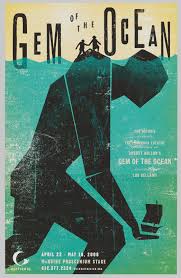 August Wilson’s Pittsburgh Cycle (a series of ten plays each set in a different decade of the 20th century) begins with Gem of the Ocean, which takes place in 1904 in the Hill District of Pittsburgh, Pennsylvania (where all of the cycle’s plays are set). Gem of the Ocean unfolds in the home of Aunt Ester, a well known 285-year-old wise woman of the town whose home has become a sanctuary for the troubled and lost. Onto the scene walks Citizen Barlow, a man who has fled from Alabama after indirectly causing another man’s death when he stole a bucket of nails. Citizen has come to Aunt Ester’s because of the tales he has heard of her soul-cleansing powers. We see Aunt Ester help guide him through a spiritual journey towards redemption and self-discovery. When an incident in the town causes the death of Solly, a former slave and conductor of the underground railroad who is dedicated to serving his people, we see Citizen step up and to continue Solly’s legacy, having discovered the importance of history and freedom. (stageagent.com)
August Wilson’s Pittsburgh Cycle (a series of ten plays each set in a different decade of the 20th century) begins with Gem of the Ocean, which takes place in 1904 in the Hill District of Pittsburgh, Pennsylvania (where all of the cycle’s plays are set). Gem of the Ocean unfolds in the home of Aunt Ester, a well known 285-year-old wise woman of the town whose home has become a sanctuary for the troubled and lost. Onto the scene walks Citizen Barlow, a man who has fled from Alabama after indirectly causing another man’s death when he stole a bucket of nails. Citizen has come to Aunt Ester’s because of the tales he has heard of her soul-cleansing powers. We see Aunt Ester help guide him through a spiritual journey towards redemption and self-discovery. When an incident in the town causes the death of Solly, a former slave and conductor of the underground railroad who is dedicated to serving his people, we see Citizen step up and to continue Solly’s legacy, having discovered the importance of history and freedom. (stageagent.com)Director Motter had a winning cast to bring “Gem” to life. Gregory Harris played Eli, who oversees Aunt Ester’s day-to-day life as a spiritual advisor. Myles McGee played Citizen Barlow, the young man from Alabama who comes to the house to be cleansed by Ester. Deborah Pearson was cast as Aunt Ester Tyler, a former slave and a “soul-cleanser”, who is the head of 1839 Wylie Avenue, where the story takes place. Wendy Pearson played Black Mary, who is Aunt Ester’s housekeeper and protégé, and whose brother, Caesar, is a domineering official in the Hill District. Neal Milner played Rutherford Selig, the traveling salesman who often visits Aunt Ester’s house. William Ammons played Solly Two Kings, an older man who often visits Aunt Ester’s house, and talks about wanting to devote himself as her lover, but they never actually get together. And Curtis Duncan played Caesar Wilks, a domineering but not very powerful member of the Hill District’s law enforcement, who, unlike his sister, Black Mary, thinks only of himself and is skeptical of Aunt Ester’s ability.
The Honolulu Star-Advertiser Review For “Gem Of The Ocean”
“Gem” was supported by a great crew that included (roles are in parentheses): Anette Kauahikaua (Assistant Director); Mary Ann Shirley Gray (Stage Manager); Andy Alvarado (Set Design & Construction); Russell Motter (Sound Design); Thomas Tochiki (Lighting Design, Light & Sound Operator); Carlynn Wolfe (Costume Design); Greg Howell (Hair & Makeup); Jason Taglianetti (Photography); Laurie Tanoura (Publicity, Program & Web Design); and Joyce Powell (Reservations & Door). Production Manager, Laurie Tanoura was everyone’s go-to person. Special Thanks went to Dave Roberts of Iolani School for Solly’s stick and Jeff Moses for the use of his antique rifle, and Catherine’s Closet, Deborah Masterson, Chris Valles, Hawaii Shakespeare Festival, Kennedy Theatre and UH-Manoa for costume assistance. And thanks to (only first names and acronym provided) Jacin, Parker, Derek, VSA, Darla, Desmond, and Sue for helping on the set.
John Berger’s “On The Scene” With Members Of The “Gem” Play
“Gem Of The Ocean” played for a total of 15 performances. It opened on Friday, February 18th, 2011, and after its opening weekend, went on to play on Thursday through Saturday nights at 7:30 p.m., and on Sunday matinees at 2:00 p.m. It closed on Sunday, March 13th, 2011. Overall, “Gem” was a hugely successful production that drew consistently great audiences, received both critical acclaim and great financial returns, and continued TAG’s climb toward the pinnacle of producing all of August Wilson’s “Pittsburgh Cycle.”
Tea With Emily Dickenson – A Staged Reading By Jan McGrath From The Belle Of Amherst By William Luce (“Black Cake” Served After)
 Emily Dickinson (see photo left), 1830–1886, was a reclusive American poet whose innovative, prolific, and emotionally intense work was largely unknown during her lifetime. She is now regarded as one of the most important figures in American poetry, celebrated for her unique style that challenged 19th-century poetic conventions. Dickinson cultivated deep and significant friendships almost entirely through her extensive correspondence, rather than through in-person interactions. These friendships included relationships with her sister-in-law Susan Huntington Gilbert and editor Thomas Wentworth Higginson. Dickinson’s style was revolutionary for her time, featuring short lines, the frequent use of slant rhyme, and unconventional capitalization and punctuation, particularly her signature dash. She explored profound and universal subjects with startling originality and compression. Recurring themes in her work include: Death and immortality; Nature; Spirituality; The identity of the self; and Love. William Luce
Emily Dickinson (see photo left), 1830–1886, was a reclusive American poet whose innovative, prolific, and emotionally intense work was largely unknown during her lifetime. She is now regarded as one of the most important figures in American poetry, celebrated for her unique style that challenged 19th-century poetic conventions. Dickinson cultivated deep and significant friendships almost entirely through her extensive correspondence, rather than through in-person interactions. These friendships included relationships with her sister-in-law Susan Huntington Gilbert and editor Thomas Wentworth Higginson. Dickinson’s style was revolutionary for her time, featuring short lines, the frequent use of slant rhyme, and unconventional capitalization and punctuation, particularly her signature dash. She explored profound and universal subjects with startling originality and compression. Recurring themes in her work include: Death and immortality; Nature; Spirituality; The identity of the self; and Love. William Luce  (see photo right), 1931–2019, was an American playwright who was primarily known for his one-person plays about notable historical figures.His most famous play is The Belle of Amherst (1976), a one-woman show about the poet Emily Dickinson, which won actress Julie Harris her fifth Tony Award. Other works include Barrymore (1997) starring Christopher Plummer and Lillian (1986) about playwright Lillian Hellman. Over his career, he wrote extensively for Broadway and television, adapting many of his solo plays for public television. Before becoming a playwright, he was a pianist, organist, and baritone singer who recorded with various chorales. The Belle of Amherst (see the playbill image below left) is a one-woman play by William Luce that provides an intimate portrait of the reclusive 19th century American poet Emily Dickenson. The play, which premiered on Broadway in 1976 starring Julie Harris, is based on Dickinson’s own letters, poems, and diary entries. It is a popular production for regional and stock theaters, having been frequently revived since its
(see photo right), 1931–2019, was an American playwright who was primarily known for his one-person plays about notable historical figures.His most famous play is The Belle of Amherst (1976), a one-woman show about the poet Emily Dickinson, which won actress Julie Harris her fifth Tony Award. Other works include Barrymore (1997) starring Christopher Plummer and Lillian (1986) about playwright Lillian Hellman. Over his career, he wrote extensively for Broadway and television, adapting many of his solo plays for public television. Before becoming a playwright, he was a pianist, organist, and baritone singer who recorded with various chorales. The Belle of Amherst (see the playbill image below left) is a one-woman play by William Luce that provides an intimate portrait of the reclusive 19th century American poet Emily Dickenson. The play, which premiered on Broadway in 1976 starring Julie Harris, is based on Dickinson’s own letters, poems, and diary entries. It is a popular production for regional and stock theaters, having been frequently revived since its  debut. The play is set in Dickinson’s Amherst, Massachusetts, home between 1845 and 1886. The actress portrays not only Emily herself, but also other people in her life, including her family, friends, and the town gossips. The plot is driven by Dickinson’s monologues and direct address to the audience, which provides insight into her creative life and her secluded world. Through her memories, Dickinson reflects on: Her relationships with her family, including her reserved father and her beloved brother Austin; Her encounters with significant figures in her life, such as her friend Helen Hunt Jackson and critic Thomas Wentworth Higginson; Her famously reclusive life, including her decision to stop attending church and stay “at home;” Her wit and sense of humor, which contrasts with the popular image of her as a melancholy spinster; and Her passion for language and poetry, which she considered to be the defining aspect of her life.
debut. The play is set in Dickinson’s Amherst, Massachusetts, home between 1845 and 1886. The actress portrays not only Emily herself, but also other people in her life, including her family, friends, and the town gossips. The plot is driven by Dickinson’s monologues and direct address to the audience, which provides insight into her creative life and her secluded world. Through her memories, Dickinson reflects on: Her relationships with her family, including her reserved father and her beloved brother Austin; Her encounters with significant figures in her life, such as her friend Helen Hunt Jackson and critic Thomas Wentworth Higginson; Her famously reclusive life, including her decision to stop attending church and stay “at home;” Her wit and sense of humor, which contrasts with the popular image of her as a melancholy spinster; and Her passion for language and poetry, which she considered to be the defining aspect of her life.
The Playbill For “Tea With Emily Dickenson”
 “Tea With Emily Dickenson” featured Jan McGrath (see photo right) reading passages from the one-woman play, “The Belle Of Amherst,” and in so doing she brought with her a lifetime of artistic history. At age 12, Jan appeared as Muriel in Eugene O’Neill’s Ah Wilderness. In the 60+ years since then, she had played over a hundred roles in professional summer stock and community theatres in New York, Pennsylvania, Maine, and Hawaii. A two-time Po`okela nominee as lead actress in The Insanity Case of Mrs. A. Lincoln, and On Golden Pond, she had also directed productions at HPU, TAG, the ACT Readers theatre and the Arts at Marks. Along with acting, directing and teaching, Jan was a writer of poetry, plays, and screenplays. Two of her plays had been presented as staged readings, and she received a first place Lorin T. Gill poetry award. In addition, she had edited numerous works for staging, including Dante’s Inferno and Milton’s Paradise Lost, and the abridged version of The Belle of Amherst used for the production. She was directed by Victoria Gail-White (see photo left), who was making her directorial debut. At
“Tea With Emily Dickenson” featured Jan McGrath (see photo right) reading passages from the one-woman play, “The Belle Of Amherst,” and in so doing she brought with her a lifetime of artistic history. At age 12, Jan appeared as Muriel in Eugene O’Neill’s Ah Wilderness. In the 60+ years since then, she had played over a hundred roles in professional summer stock and community theatres in New York, Pennsylvania, Maine, and Hawaii. A two-time Po`okela nominee as lead actress in The Insanity Case of Mrs. A. Lincoln, and On Golden Pond, she had also directed productions at HPU, TAG, the ACT Readers theatre and the Arts at Marks. Along with acting, directing and teaching, Jan was a writer of poetry, plays, and screenplays. Two of her plays had been presented as staged readings, and she received a first place Lorin T. Gill poetry award. In addition, she had edited numerous works for staging, including Dante’s Inferno and Milton’s Paradise Lost, and the abridged version of The Belle of Amherst used for the production. She was directed by Victoria Gail-White (see photo left), who was making her directorial debut. At  the time, she had performed on TAG’s various stages since 2002 where she received a Po`okela for leading female in a play in TAG’s production of Edward Albee’s The Goat or Who Is Sylvia in 2006. In On Golden Pond, staged in 2003 at TAG, she had played Jan McGrath’s daughter and had come to call her “mom” ever since. In the true sense of what goes around comes around, Victoria was returning the favor to Jan, after having been directed by her five times. Jan and Victoria were supported by an effective crew who they accorded Special Thanks to in the play program. This included Peggy Krock (for costumes), Tom Holowach, Roxanne Vogelgesang, Noe Tanigawa, and Pat Martin.
the time, she had performed on TAG’s various stages since 2002 where she received a Po`okela for leading female in a play in TAG’s production of Edward Albee’s The Goat or Who Is Sylvia in 2006. In On Golden Pond, staged in 2003 at TAG, she had played Jan McGrath’s daughter and had come to call her “mom” ever since. In the true sense of what goes around comes around, Victoria was returning the favor to Jan, after having been directed by her five times. Jan and Victoria were supported by an effective crew who they accorded Special Thanks to in the play program. This included Peggy Krock (for costumes), Tom Holowach, Roxanne Vogelgesang, Noe Tanigawa, and Pat Martin.
Emily Dickenson’s “Black Cake” Recipe
“Tea With Emily Dickenson” played for two nights, Saturday, March 26th, 2011, and Sunday, March 27th, 2011. The performances were held during TAG’s usual 7:30 p.m evening start (the Saturday performance) and its 2:00 p.m. matinee start (the Sunday performance). Both shows were attended by a number of TAG’s patrons and fans of Jan McGrath, who partook in High Tea following each reading with gourmet treats and champagne, courtesy of director and chef Victoria Gail-White, featuring “Black Cake” from Emily’s own recipe.
The Miracle Worker – Staging A Movie Classic
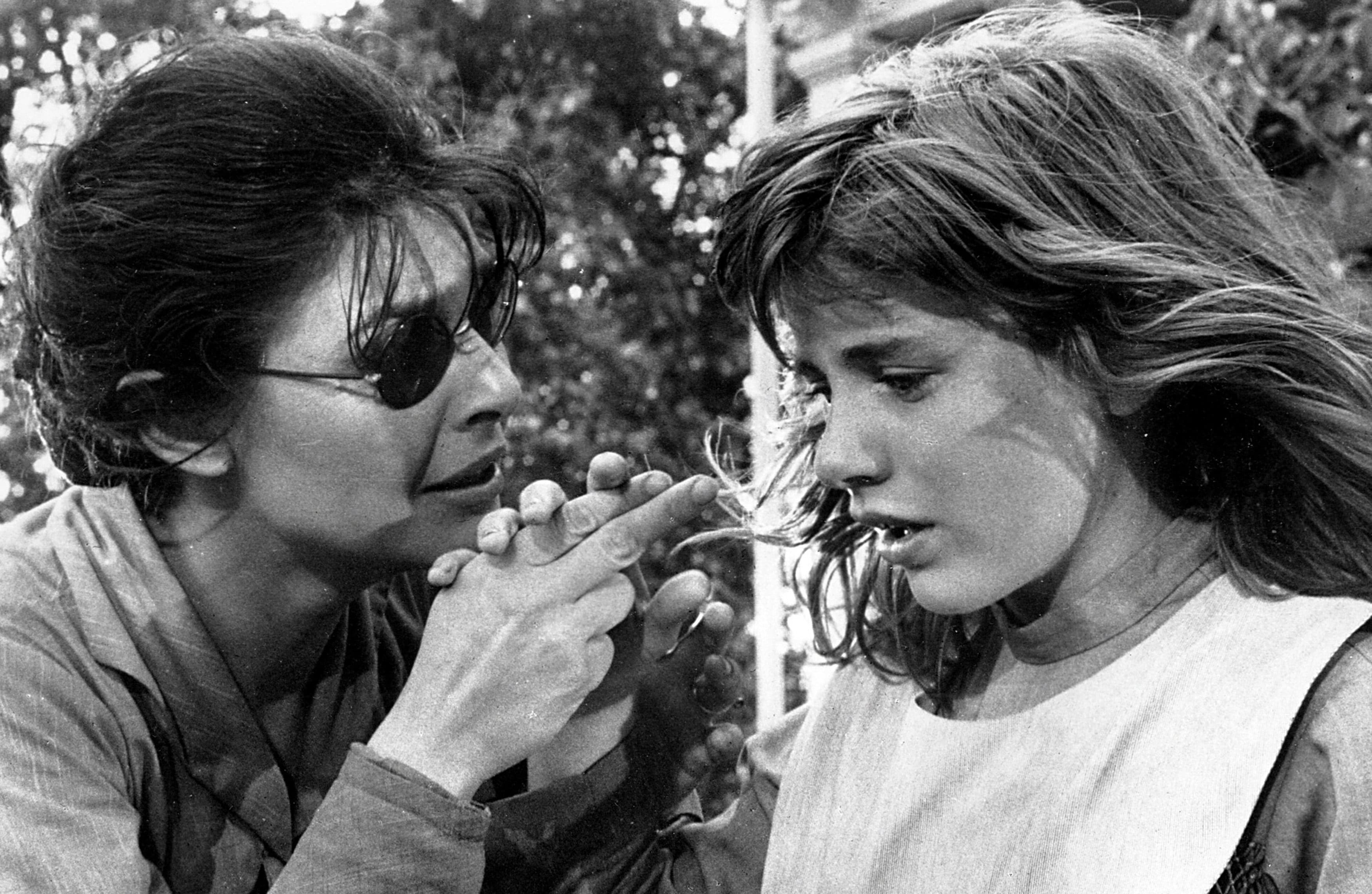 Mention to any of the largely Baby Boomer members of TAG’s regular attendees, ‘The Miracle Worker,’ and you would undoubtedly be told that it is the title of the 1962 movie of the same name that was about deaf and blind Helen Keller and her amazing tutor, governess, companion, and subsequent life-long friend, Anne Sullivan. The film went on to be an instant critical success and a moderate commercial success, and was nominated for five Academy Awards, including Best Director for Arthur Penn, and won two awards, Best Actress for Anne Bancroft (left in inset photo) and Best Supporting Actress for Patty Duke (right in inset photo), the latter of whom, at age 16, became the youngest competitive Oscar winner at the time. Its pivotal moment (“She knows!”) in which Sullivan makes a breakthrough with Keller as the latter touches water, remains one of the most riveting and remembered scenes in all the annals of movie-making. In 2024, the film was selected for preservation in the United States National Film Registry by the Library of Congress as being “culturally, historically, or aesthetically significant.” But few realize that this amazing movie was actually initially written as a play by William Gibson (see below), and that it premiered on Broadway at the Playhouse Theatre on October 19th, 1959, and closed on July 1st, 1961, after 719 performances, where both Bancroft and Duke first portrayed their characters, under the direction of Penn.
Mention to any of the largely Baby Boomer members of TAG’s regular attendees, ‘The Miracle Worker,’ and you would undoubtedly be told that it is the title of the 1962 movie of the same name that was about deaf and blind Helen Keller and her amazing tutor, governess, companion, and subsequent life-long friend, Anne Sullivan. The film went on to be an instant critical success and a moderate commercial success, and was nominated for five Academy Awards, including Best Director for Arthur Penn, and won two awards, Best Actress for Anne Bancroft (left in inset photo) and Best Supporting Actress for Patty Duke (right in inset photo), the latter of whom, at age 16, became the youngest competitive Oscar winner at the time. Its pivotal moment (“She knows!”) in which Sullivan makes a breakthrough with Keller as the latter touches water, remains one of the most riveting and remembered scenes in all the annals of movie-making. In 2024, the film was selected for preservation in the United States National Film Registry by the Library of Congress as being “culturally, historically, or aesthetically significant.” But few realize that this amazing movie was actually initially written as a play by William Gibson (see below), and that it premiered on Broadway at the Playhouse Theatre on October 19th, 1959, and closed on July 1st, 1961, after 719 performances, where both Bancroft and Duke first portrayed their characters, under the direction of Penn.
The Blurred (But At Least Available) Playbill For “The Miracle Worker”
To direct the stage version of “The Miracle Worker,” was TAG’s Production Manager, Laurie Tanoura, taking her turn at directing, on top of maintaining her usual full-plate schedule. She brought with her an outstanding cast (characters are in parentheses): Hoku Gilbert (Anne Sullivan); Kathryn Jurbala (Helen Keller); Gerald Altwies (Captain Keller); Lea Grupen (Kate Keller); Suzanne Maloney (Aunt Ev); Scott Francis Russell (James Keller); S. Rick Crump (Doctor); Richard Goodman (Anagnos); Mary Ann Shirley Gray (Viney); Wesley Westbrooke (Percy); Dila Westbrooke (Martha); Lanihuli Gilbert (Beatrice); Kira Stone (Emma); Alyse Glaser (Sara); Alana Glaser (Alice); Cova Li (Jane); and Maile (Belle). Supporting Director and Production Manager Laurie was a small but totally dedicated crew (roles or responsibilities in parentheses): Terri Madden (Assistant Director & Stage Manager); Carlynn Wolfe (Costume Design); Andy Alvarado (Set Design & Construction); Thomas Tochiki (Lighting Design, Light & Sound Operator); and Clara Lam (Props & Backstage Manager).
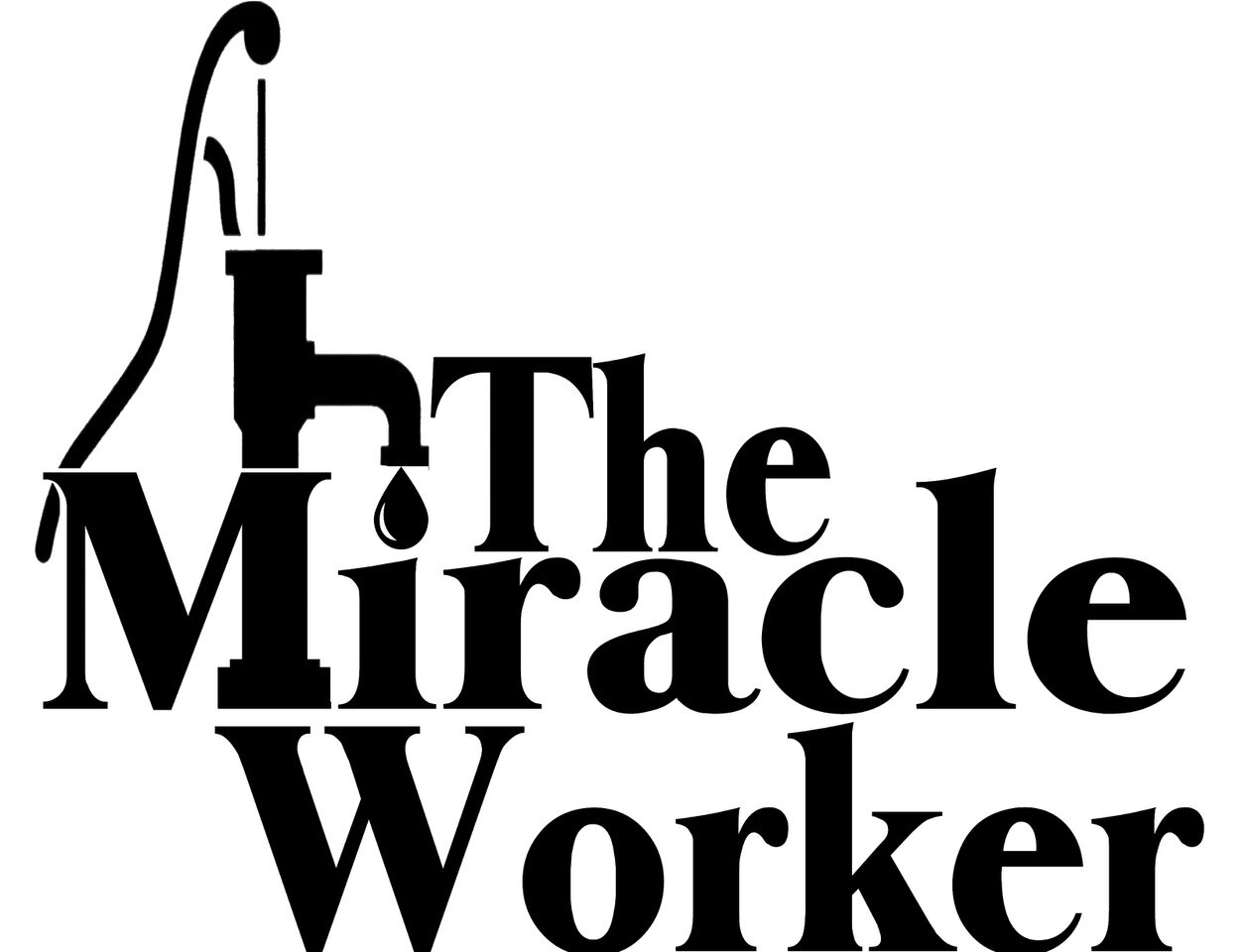 “The Miracle Worker” is a powerful play by William Gibson that tells the compelling story of Helen Keller, who, after losing her sight and hearing as a child, struggles with isolation and communication. Set in Tuscumbia, Alabama, the narrative begins with the Keller family’s plight as they learn of Helen’s condition following a life-threatening fever. The pivotal character, Annie Sullivan, is brought to help Helen after her family seeks assistance from the Perkins Institute for the Blind. Annie, who herself has experienced institutionalization and blindness, understands Helen’s challenges and aims to teach her language as a means of connection. As the story unfolds, Annie faces the daunting task of not only educating Helen in language but also instilling discipline in an environment where Helen’s misbehavior has been indulged by her family. Through a series of struggles and breakthroughs, the relationship between teacher and student evolves, culminating in a transformative moment when Helen finally grasps that words represent objects and ideas, allowing her to step out of her isolated existence. The play ultimately highlights themes of perseverance, communication, and the profound human capacity for understanding, leaving a lasting impact on audiences. (ebsco.com)
“The Miracle Worker” is a powerful play by William Gibson that tells the compelling story of Helen Keller, who, after losing her sight and hearing as a child, struggles with isolation and communication. Set in Tuscumbia, Alabama, the narrative begins with the Keller family’s plight as they learn of Helen’s condition following a life-threatening fever. The pivotal character, Annie Sullivan, is brought to help Helen after her family seeks assistance from the Perkins Institute for the Blind. Annie, who herself has experienced institutionalization and blindness, understands Helen’s challenges and aims to teach her language as a means of connection. As the story unfolds, Annie faces the daunting task of not only educating Helen in language but also instilling discipline in an environment where Helen’s misbehavior has been indulged by her family. Through a series of struggles and breakthroughs, the relationship between teacher and student evolves, culminating in a transformative moment when Helen finally grasps that words represent objects and ideas, allowing her to step out of her isolated existence. The play ultimately highlights themes of perseverance, communication, and the profound human capacity for understanding, leaving a lasting impact on audiences. (ebsco.com)
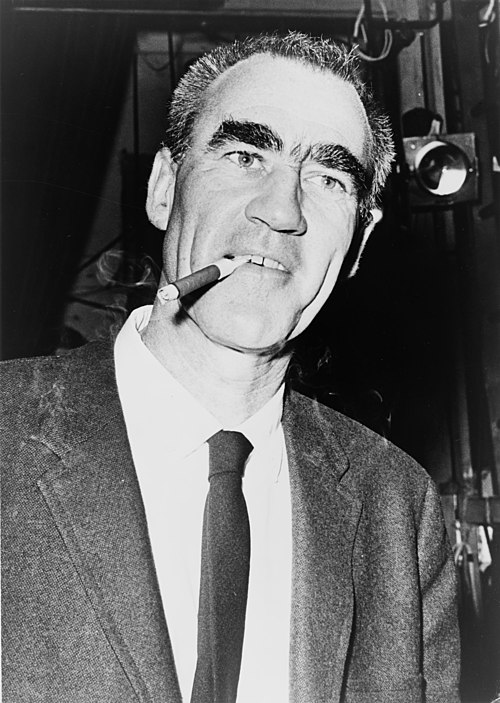 William Gibson (photo right) was born on November 13, 1914 in the Bronx, New York City, New York, USA. He was a writer, known for The Miracle Worker (1962), Playhouse 90 (1956) and Two for the Seesaw (1962). He was married to Margaret Brenman-Gibson. He died on November 25, 2008 in Stockbridge, Massachusetts, USA. Most of his work is about helping people, such as his play, “The Miracle Worker,” based on Helen Keller’s teacher, Anne Sullivan. He won two Tony Awards in 1960 for “The Miracle Worker,” as Best Author (Dramatic) and as author of the Best Play winner. He was also nominated two other times: in 1958 as author of the Best Play nominee, “Two for the Seesaw,” and in 1965 as co-author, with Clifford Odets, of the book for Best Musical nominee, “Golden Boy.” (imdb.com)
William Gibson (photo right) was born on November 13, 1914 in the Bronx, New York City, New York, USA. He was a writer, known for The Miracle Worker (1962), Playhouse 90 (1956) and Two for the Seesaw (1962). He was married to Margaret Brenman-Gibson. He died on November 25, 2008 in Stockbridge, Massachusetts, USA. Most of his work is about helping people, such as his play, “The Miracle Worker,” based on Helen Keller’s teacher, Anne Sullivan. He won two Tony Awards in 1960 for “The Miracle Worker,” as Best Author (Dramatic) and as author of the Best Play winner. He was also nominated two other times: in 1958 as author of the Best Play nominee, “Two for the Seesaw,” and in 1965 as co-author, with Clifford Odets, of the book for Best Musical nominee, “Golden Boy.” (imdb.com)
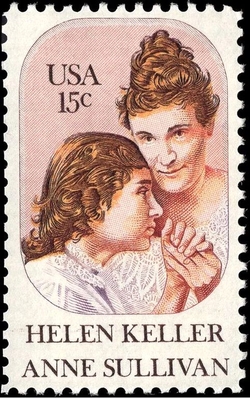 The story of Helen Keller and Anne Sullivan is universally acknowledged as one of the most inspirational stories of all time, and has been portrayed in the media a number of times. Keller, herself, wrote the first book about her experiences in, “The Story Of My Life,” in 1903, and her life, along with that of Sullivan, has since been chronicled numerous times by many other authors. In terms of the celluloid, television, and stage mediums, their story was first portrayed in the 1919 silent film, Deliverance (see below), where a younger Anne is played by Edith Lyle and a young Helen is played by Etna Ross (other actresses portray the two as they age). Sullivan is the main character in the play, The Miracle Worker, by William Gibson, which was originally produced for television in 1957, in which Anne was portrayed by Teresa Wright, and Helen by Patricia McCormack. The Miracle Worker then moved to Broadway and later was produced as a 1962 feature film. Both the play and the film featured Anne Bancroft as Sullivan. Patty Duke, who played Keller on Broadway and in the 1962 film, later played Sullivan in a 1979 television remake, where Keller was played by Melissa Gilbert. Blythe Danner portrayed Anne, and Mare Winningham played Helen in the TV movie, The Miracle Continues, and Roma Downey portrayed Anne in another TV movie, Monday After the Miracle (1998), where Helen was played by Moira Kelly. Alison Elliott portrayed Anne in a 2000 television movie where Hallie Eisenberg portrayed Helen. Alison Pill played Sullivan on Broadway in a short-lived 2010 revival, with Abigail Breslin as Keller. In 1980, the United States Postal Service issued a commemorative stamp (see left photo), honoring Sullivan and Keller. (paraphrased from various wikipedia.com sites on Sullivan and Keller).
The story of Helen Keller and Anne Sullivan is universally acknowledged as one of the most inspirational stories of all time, and has been portrayed in the media a number of times. Keller, herself, wrote the first book about her experiences in, “The Story Of My Life,” in 1903, and her life, along with that of Sullivan, has since been chronicled numerous times by many other authors. In terms of the celluloid, television, and stage mediums, their story was first portrayed in the 1919 silent film, Deliverance (see below), where a younger Anne is played by Edith Lyle and a young Helen is played by Etna Ross (other actresses portray the two as they age). Sullivan is the main character in the play, The Miracle Worker, by William Gibson, which was originally produced for television in 1957, in which Anne was portrayed by Teresa Wright, and Helen by Patricia McCormack. The Miracle Worker then moved to Broadway and later was produced as a 1962 feature film. Both the play and the film featured Anne Bancroft as Sullivan. Patty Duke, who played Keller on Broadway and in the 1962 film, later played Sullivan in a 1979 television remake, where Keller was played by Melissa Gilbert. Blythe Danner portrayed Anne, and Mare Winningham played Helen in the TV movie, The Miracle Continues, and Roma Downey portrayed Anne in another TV movie, Monday After the Miracle (1998), where Helen was played by Moira Kelly. Alison Elliott portrayed Anne in a 2000 television movie where Hallie Eisenberg portrayed Helen. Alison Pill played Sullivan on Broadway in a short-lived 2010 revival, with Abigail Breslin as Keller. In 1980, the United States Postal Service issued a commemorative stamp (see left photo), honoring Sullivan and Keller. (paraphrased from various wikipedia.com sites on Sullivan and Keller).
“Deliverance” – The First Film Media Depiction Of The Anne Sullivan & Helen Keller Story
The Honolulu Star-Advertiser Review For “The Miracle Worker”
Production Manager And Director Laurie Tanoura
With Laurie Tanoura wearing many hats, “The Miracle Worker” turned into a great TAG success and played for a total of 15 performances. It opened on Friday, April 22nd, 2011 and closed on Sunday, May 15th, 2011. Thursday through Saturday night performances were at 7:30 p.m., and Sunday matinees at 2:00 p.m. It attracted good audiences who greatly appreciated the re-staging of a Hollywood classic.
The Postcard For “The Miracle Worker”
A Delicate Balance – Brother Gary Directs Another Great Albee Play
 For the final play of the 2010-2011 season, TAG Artistic Director Brad Powell arranged for Brother Gary Morris to direct another great play by Edward Albee (see photo right), “A Delicate Balance,” which was Albee’s three-act play that was written in 1965. It premiered in 1966, on Broadway when it was directed by Alan Schneider, opening at the Martin Beck Theatre on September 22, 1966, and closing on January 14, 1967, after 132 performances and 12 previews. It won the Pulitzer Prize for Drama in 1967, the first of three that Albee would receive for his work. A revival produced by the Lincoln Center Theater at the Plymouth Theatre opened on April 21, 1996, and ran for 185 performances and 27 previews. It was directed by Gerald Gutierrez. The production won the Tony Award for Best Revival of a Play, as well as a Tony Award for Gutierrez, and the Drama Desk Award for Outstanding Revival of a Play. A 1973 film adaptation was directed by Tony Richardson for the short-lived American Film Theater series. Subsequently produced innumerable times by theaters across the U.S.A and abroad, “A Delicate Balance,” one of Albee’s best, would be the next outstanding play on tap for TAG.
For the final play of the 2010-2011 season, TAG Artistic Director Brad Powell arranged for Brother Gary Morris to direct another great play by Edward Albee (see photo right), “A Delicate Balance,” which was Albee’s three-act play that was written in 1965. It premiered in 1966, on Broadway when it was directed by Alan Schneider, opening at the Martin Beck Theatre on September 22, 1966, and closing on January 14, 1967, after 132 performances and 12 previews. It won the Pulitzer Prize for Drama in 1967, the first of three that Albee would receive for his work. A revival produced by the Lincoln Center Theater at the Plymouth Theatre opened on April 21, 1996, and ran for 185 performances and 27 previews. It was directed by Gerald Gutierrez. The production won the Tony Award for Best Revival of a Play, as well as a Tony Award for Gutierrez, and the Drama Desk Award for Outstanding Revival of a Play. A 1973 film adaptation was directed by Tony Richardson for the short-lived American Film Theater series. Subsequently produced innumerable times by theaters across the U.S.A and abroad, “A Delicate Balance,” one of Albee’s best, would be the next outstanding play on tap for TAG.
The Playbill For “A Delicate Balance”
 Brother Gary (photo left) was able to round up a first class cast. To play Agnes, the handsome wife and mother in her late fifties, was Frankie Enos. Haunted by the possibility of losing her mind, which she defines as a kind of “drifting,” whereby she would become a stranger in the world, she attempts to maintain order, a “delicate balance,” in her world. She deals with the emotional withdrawal of her husband and the “embarrassment” of her sister by taking the verbal initiative to judge and thereby control them. She comes to realize that her hold on reality depends more on them than she has been willing to admit, and that frightens her. To play Tobias, her husband, a few years older, was Wil Kahele. An emotionally repressed and withdrawn man, Tobias covers his deepest fears with a mask of self-control and quiet, and he suppresses them with alcohol. Forced by Agnes to make a decision about whether Harry and Edna will stay, he breaks down under the weight of trying to be honest about how he really feels, not only about them but also about his own family. He has a hysterical fear of death and of being alone, and this allows him to tolerate demands of his family. To play Claire, Agnes’ alcoholic younger sister, was Laurie Tanoura. Called an ingrate and one of the walking wounded by Agnes, Claire is nevertheless the most honest person in the family. She does not hide her feelings or her dark side. She uses her drinking to annoy and embarrass Agnes; to amuse Tobias, with whom she might have had an affair; to prick Julia’s pretensions; and to thumb her nose at society. She is a weary, but tough, survivor. To play Julia, Agnes and Tobias’ thirty-six-year-old daughter, recently separated from her fourth husband, was Danielle Zalopany. Returning home with a sense of failure and with raw emotions, she is like a younger version of Claire, for whom she has much admiration and affection. She needs her childhood room, which symbolizes a measure of order in her chaotic emotional life; the fact that it is occupied by her godparents causes her to become hysterical. She realizes that her arrival will necessitate changes in the alliances that have held Agnes, Tobias, and Claire in their uncomfortable triangle. To play Harry and Edna, Agnes’ and Tobias’ best friends and godparents to Julia, were Dale Hathaway and Suzanne Maloney. Frightened by a “terror” that remains unnameable, they are “intruders” in the household. Like the plague, their fear is contagious; each character reads his or her own personal agony into it. The women of the house want them to go; Tobias begs them to stay. In leaving by their own choice, they force the family to confront and acknowledge their personal fears. The terror seems to be existential in nature, a glimpse into the passage of time, death, and alienation. (descriptions taken from ebsco.com)
Brother Gary (photo left) was able to round up a first class cast. To play Agnes, the handsome wife and mother in her late fifties, was Frankie Enos. Haunted by the possibility of losing her mind, which she defines as a kind of “drifting,” whereby she would become a stranger in the world, she attempts to maintain order, a “delicate balance,” in her world. She deals with the emotional withdrawal of her husband and the “embarrassment” of her sister by taking the verbal initiative to judge and thereby control them. She comes to realize that her hold on reality depends more on them than she has been willing to admit, and that frightens her. To play Tobias, her husband, a few years older, was Wil Kahele. An emotionally repressed and withdrawn man, Tobias covers his deepest fears with a mask of self-control and quiet, and he suppresses them with alcohol. Forced by Agnes to make a decision about whether Harry and Edna will stay, he breaks down under the weight of trying to be honest about how he really feels, not only about them but also about his own family. He has a hysterical fear of death and of being alone, and this allows him to tolerate demands of his family. To play Claire, Agnes’ alcoholic younger sister, was Laurie Tanoura. Called an ingrate and one of the walking wounded by Agnes, Claire is nevertheless the most honest person in the family. She does not hide her feelings or her dark side. She uses her drinking to annoy and embarrass Agnes; to amuse Tobias, with whom she might have had an affair; to prick Julia’s pretensions; and to thumb her nose at society. She is a weary, but tough, survivor. To play Julia, Agnes and Tobias’ thirty-six-year-old daughter, recently separated from her fourth husband, was Danielle Zalopany. Returning home with a sense of failure and with raw emotions, she is like a younger version of Claire, for whom she has much admiration and affection. She needs her childhood room, which symbolizes a measure of order in her chaotic emotional life; the fact that it is occupied by her godparents causes her to become hysterical. She realizes that her arrival will necessitate changes in the alliances that have held Agnes, Tobias, and Claire in their uncomfortable triangle. To play Harry and Edna, Agnes’ and Tobias’ best friends and godparents to Julia, were Dale Hathaway and Suzanne Maloney. Frightened by a “terror” that remains unnameable, they are “intruders” in the household. Like the plague, their fear is contagious; each character reads his or her own personal agony into it. The women of the house want them to go; Tobias begs them to stay. In leaving by their own choice, they force the family to confront and acknowledge their personal fears. The terror seems to be existential in nature, a glimpse into the passage of time, death, and alienation. (descriptions taken from ebsco.com)
 “A Delicate Balance” is a drama by Edward Albee that delves into the complexities of familial relationships and existential anxieties within a seemingly affluent suburban setting. The play centers around Agnes and Tobias, an elderly couple who grapple with personal fears and family turmoil, particularly concerning their daughter Julia’s tumultuous marital history. As they enjoy an evening at home, unexpected guests, Harry and Edna, arrive, disturbed by an irrational fear that compels them to seek refuge in Agnes’ and Tobias’s home. The narrative unfolds against the backdrop of these interpersonal dynamics, revealing themes of communication, alcoholism, and the fragility of mental stability. Tensions escalate as characters confront their emotional baggage—Agnes’ concern for her mental health, Claire’s struggle with alcohol, and Julia’s volatile relationships. The play presents a poignant exploration of the delicate balance between maintaining harmony and confronting uncomfortable truths, ultimately reflecting on the nature of companionship and the existential fears that can disrupt it. Through its intricate character interactions and underlying absurdity, Albee’s work invites audiences to contemplate the intricacies of human connection in the face of life’s uncertainties.
“A Delicate Balance” is a drama by Edward Albee that delves into the complexities of familial relationships and existential anxieties within a seemingly affluent suburban setting. The play centers around Agnes and Tobias, an elderly couple who grapple with personal fears and family turmoil, particularly concerning their daughter Julia’s tumultuous marital history. As they enjoy an evening at home, unexpected guests, Harry and Edna, arrive, disturbed by an irrational fear that compels them to seek refuge in Agnes’ and Tobias’s home. The narrative unfolds against the backdrop of these interpersonal dynamics, revealing themes of communication, alcoholism, and the fragility of mental stability. Tensions escalate as characters confront their emotional baggage—Agnes’ concern for her mental health, Claire’s struggle with alcohol, and Julia’s volatile relationships. The play presents a poignant exploration of the delicate balance between maintaining harmony and confronting uncomfortable truths, ultimately reflecting on the nature of companionship and the existential fears that can disrupt it. Through its intricate character interactions and underlying absurdity, Albee’s work invites audiences to contemplate the intricacies of human connection in the face of life’s uncertainties.
To assist Brother Gary was the usual TAG crew of outstanding volunteers and specialists. These included (roles and responsibilities in parentheses): Jaren Maluyo (Assistant Director & Stage Manager); Sam Spengler (Stage Manager); Andy Alvarado & Brother Gary Morris (Set Design); Andy Alvarado (Set Construction); Brother Gary Morris (Sound Design); Thomas Tochiki (Lighting Design, Light & Sound Operator); Carlynn Wolfe (Costume Design); Greg Howell (Hair & Makeup); and Jason Taglianetti (Photography). Special Thanks were accorded to Sara Ward and Manoa Valley Theatre for the accordion, Chaminade University Performing Arts Department for props and decor, and Rose Wolfe and Terry Oshiro.
The Honolulu Star-Advertiser Review Of “A Delicate Balance”
The Postcard For “A Delicate Balance”
“A Delicate Balance” opened to a warm and appreciative crowd on Friday, June 24th, 2011 and went on to attract consistently good audiences during a run of 15 total performances until closing on Sunday, July 17th, 2011. Thursday through Saturday night shows were at 7:30 p.m. and Sunday matinees were at 2:00 pm.
The Play Announcement That Appeared On FirstFriday.Com


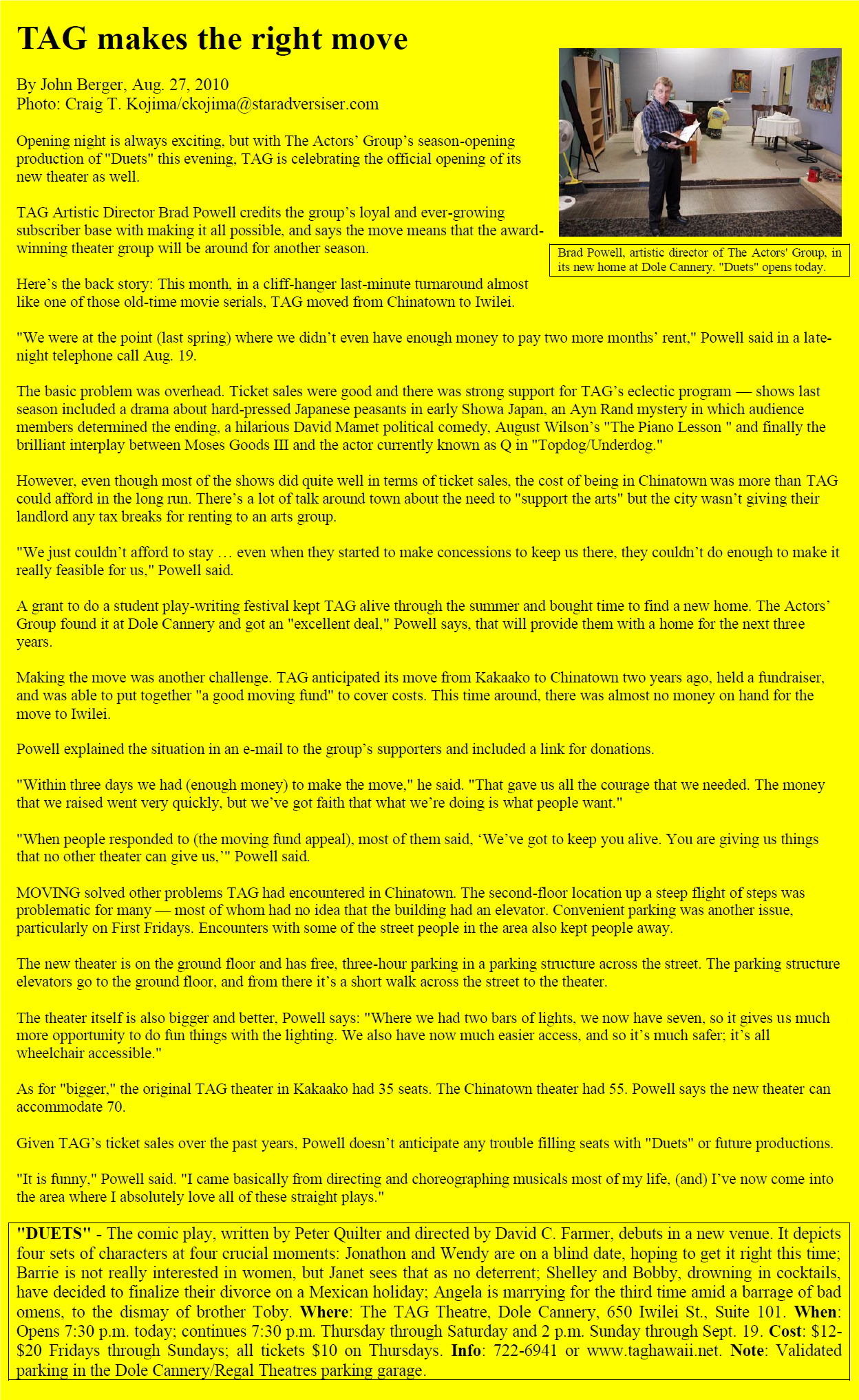
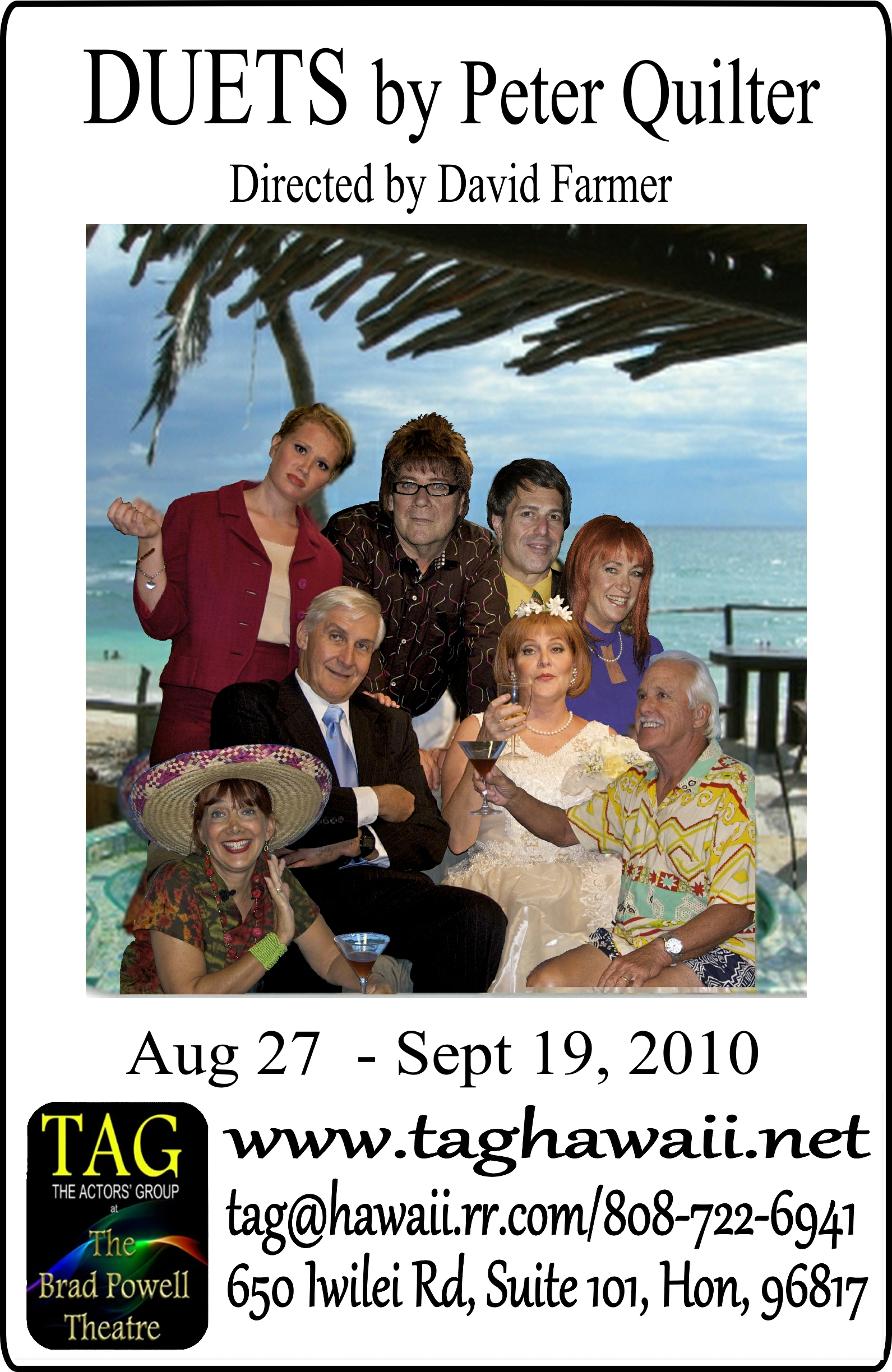
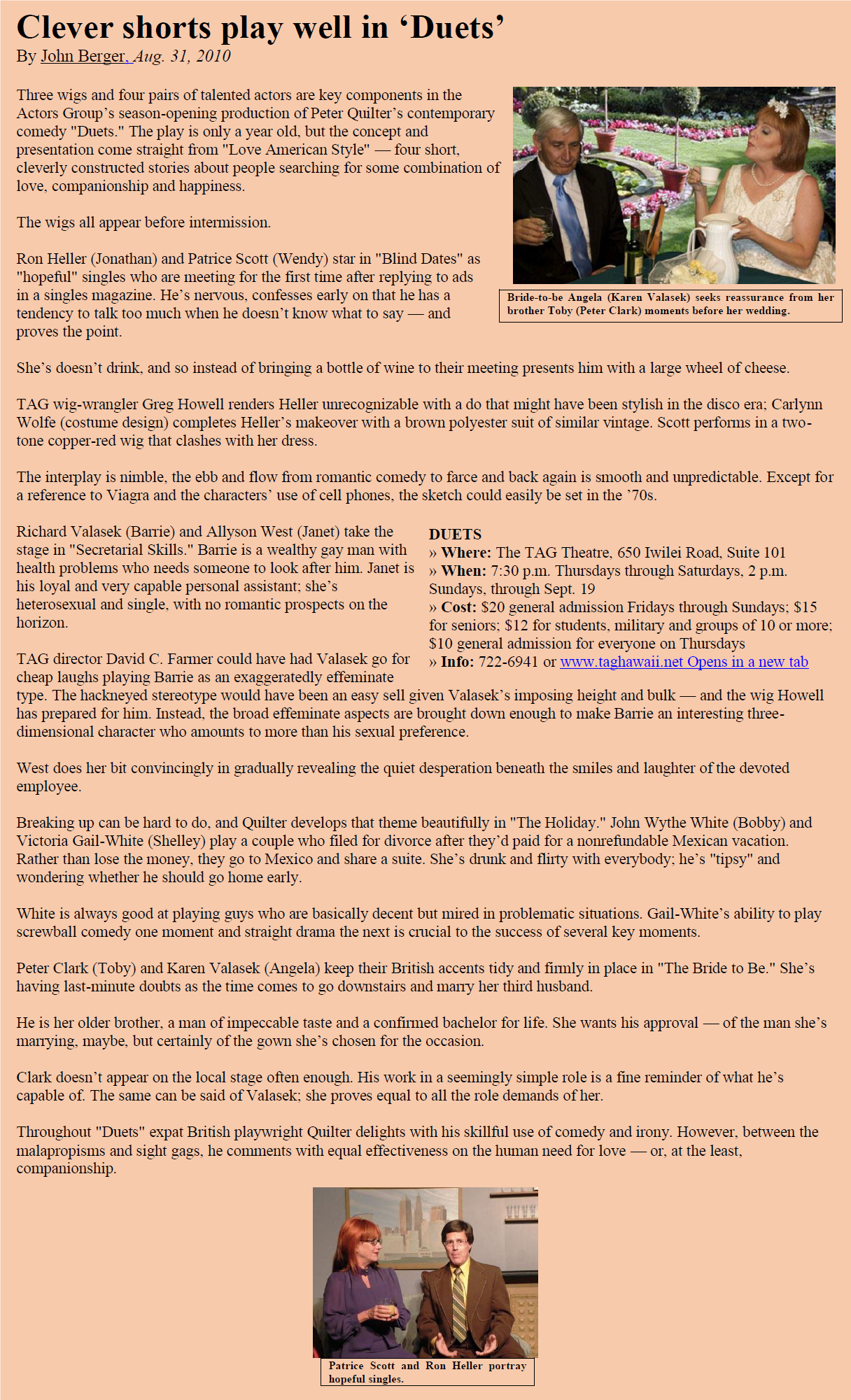
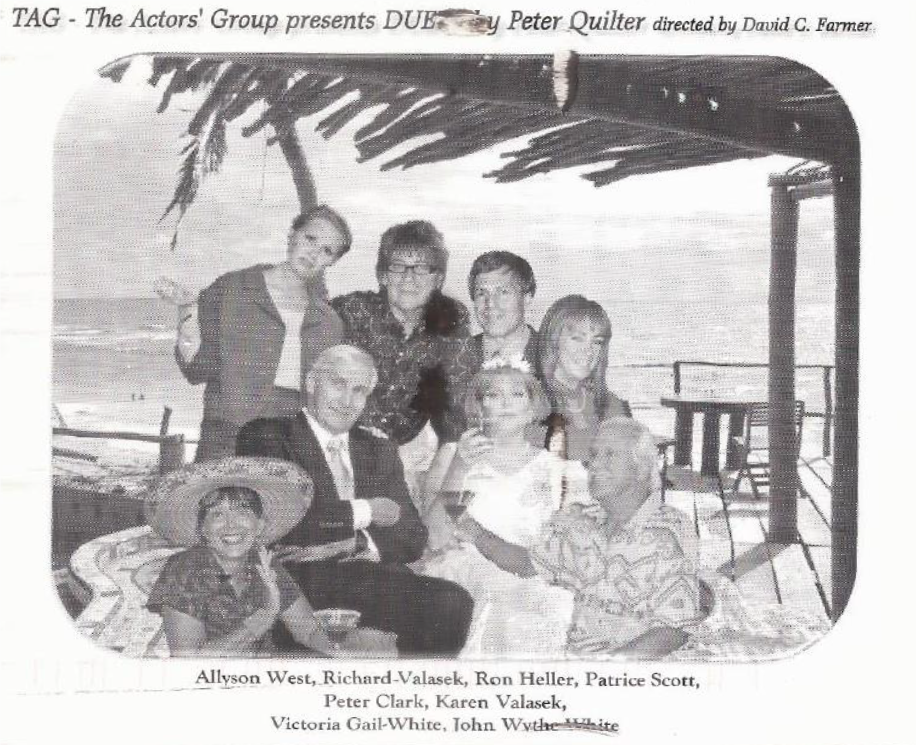
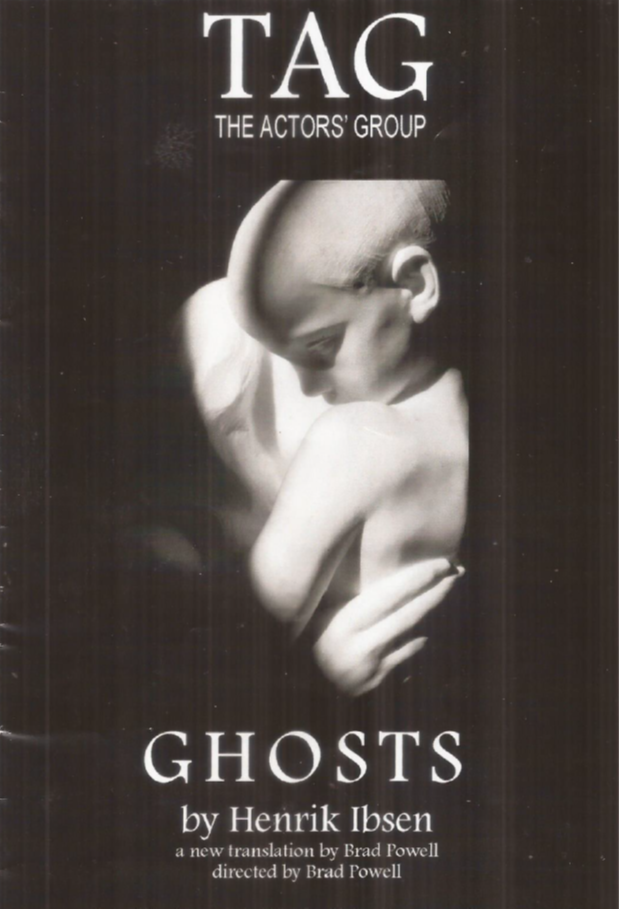
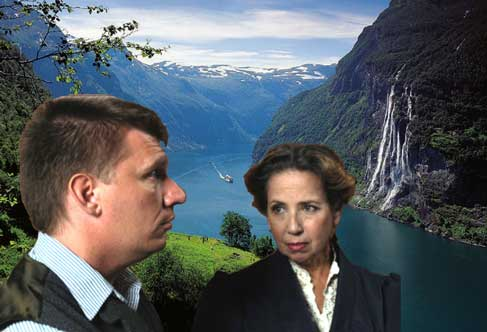
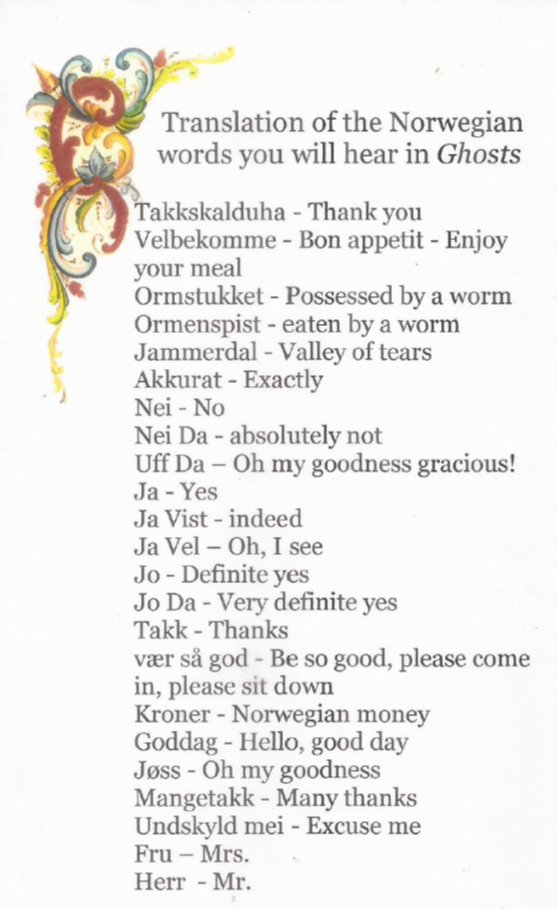
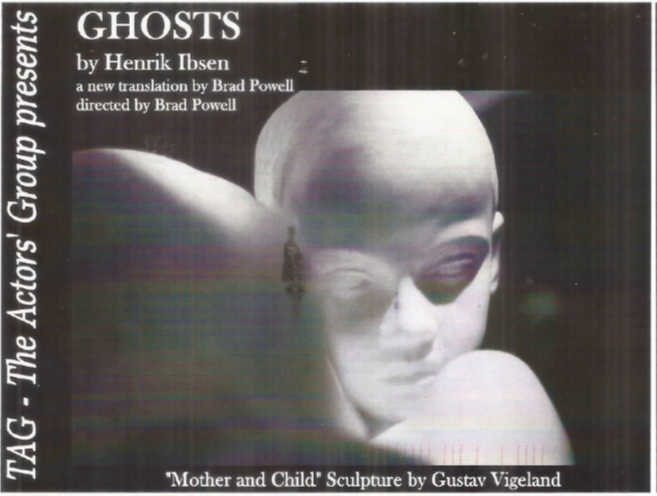
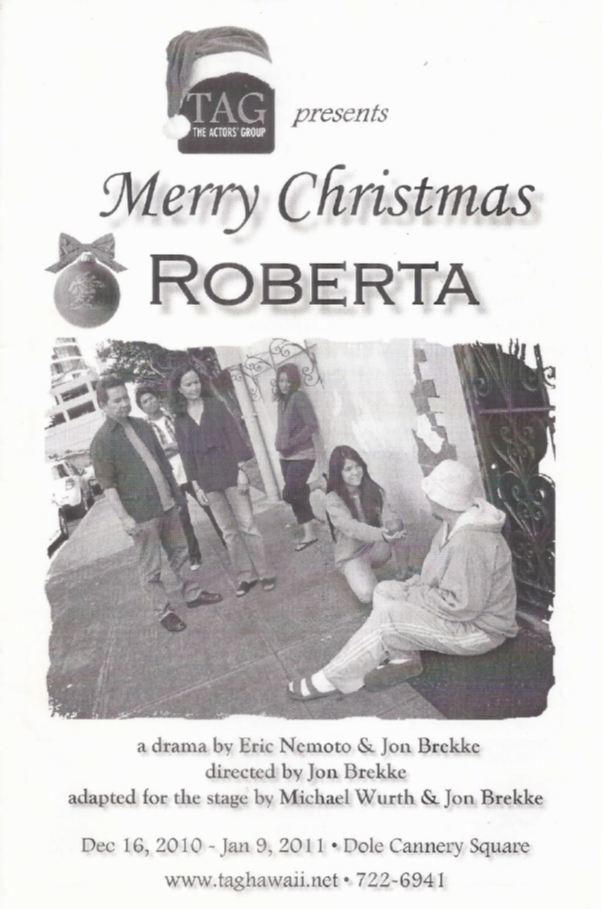
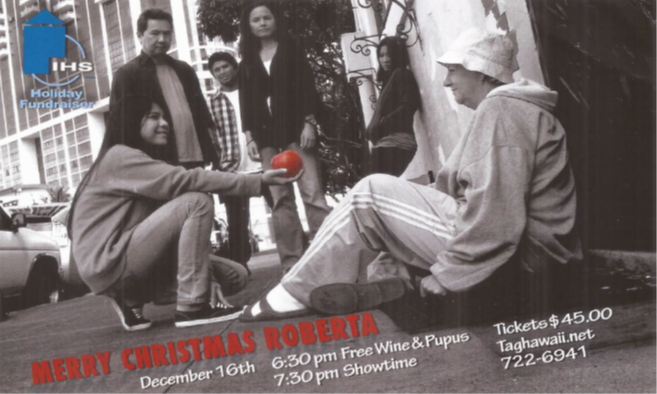

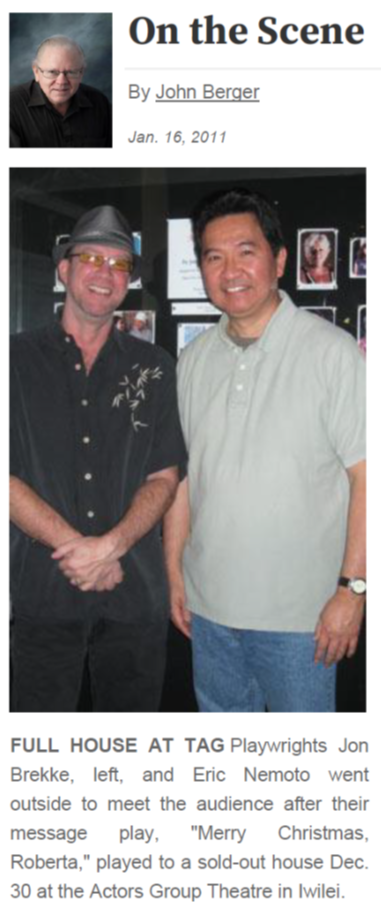
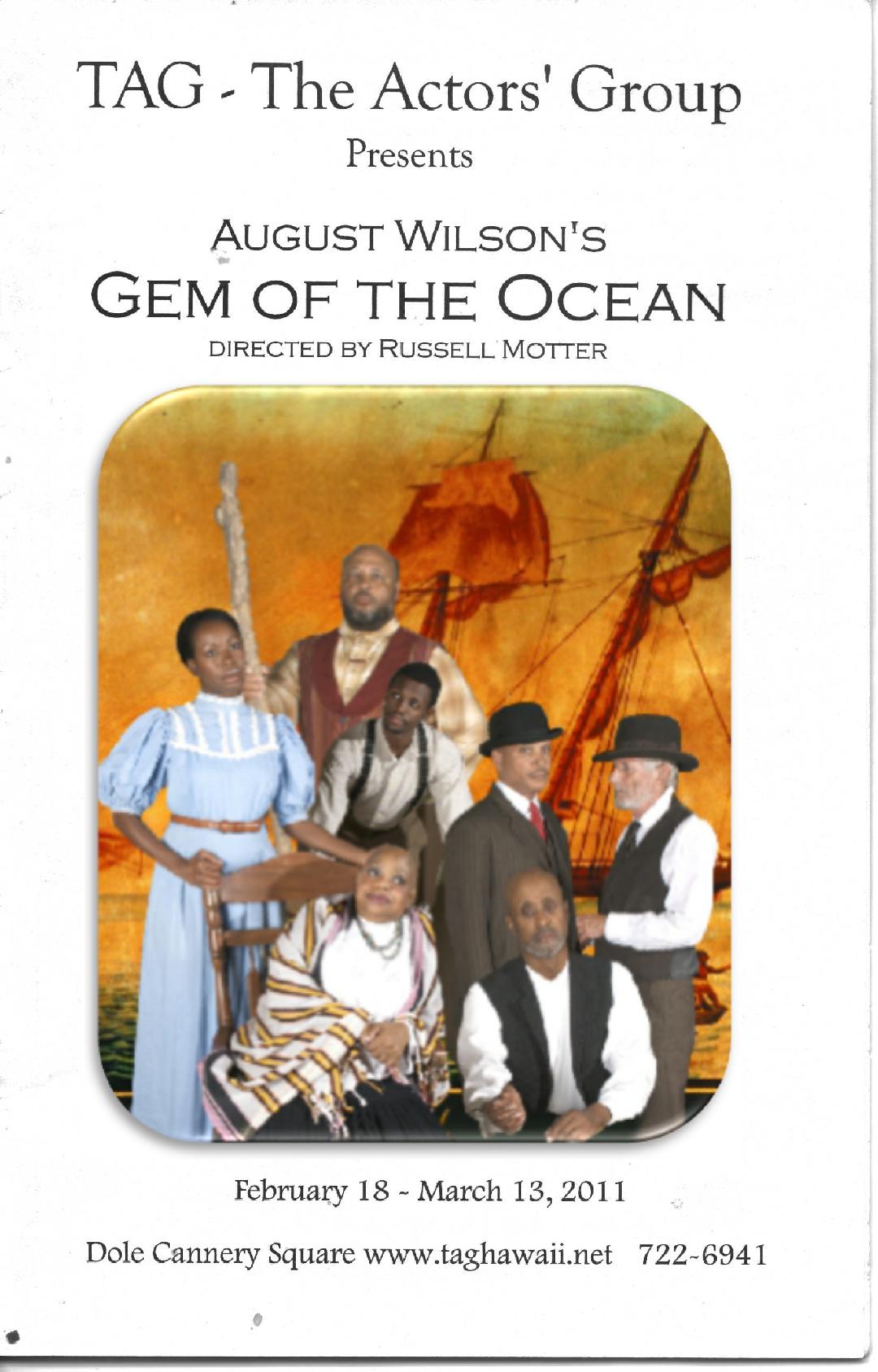
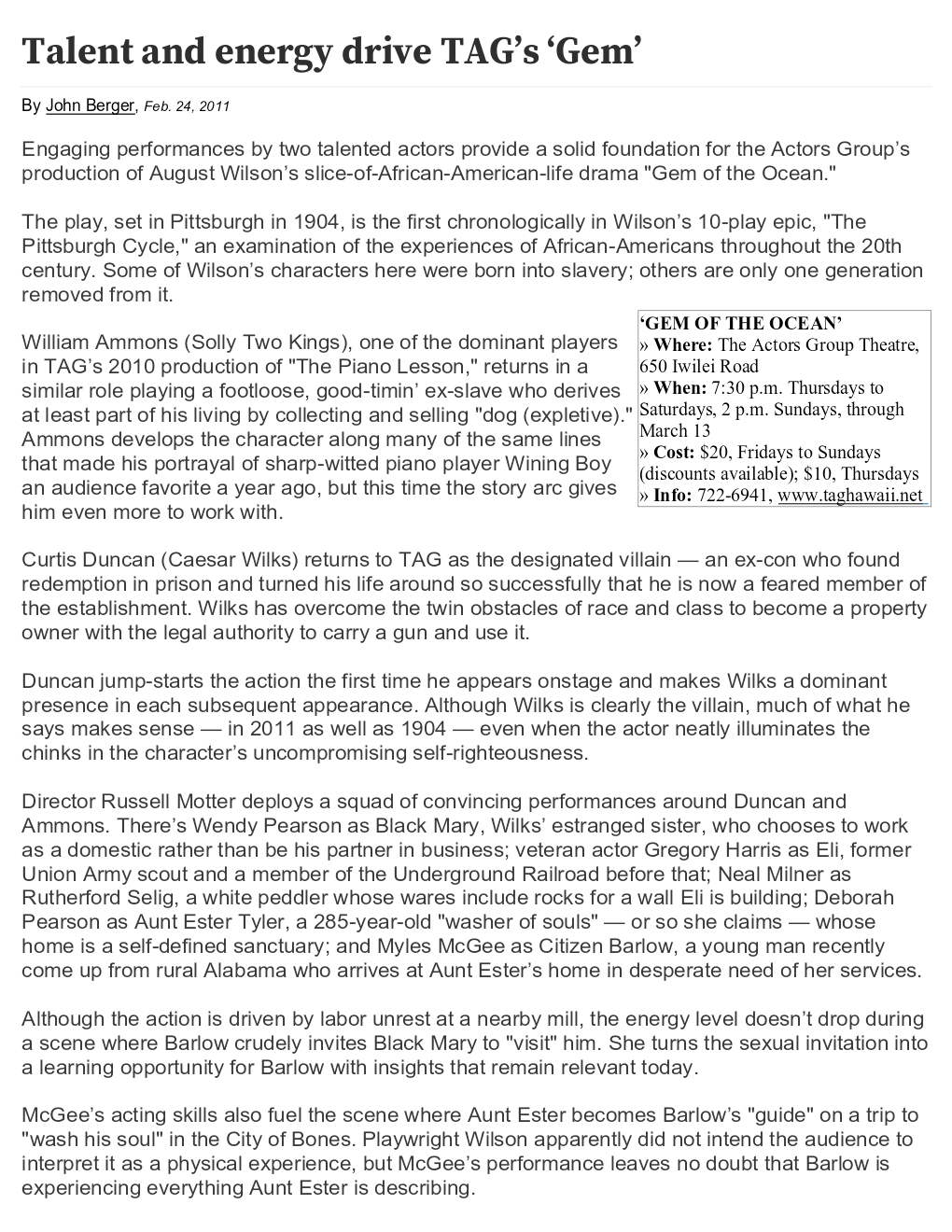
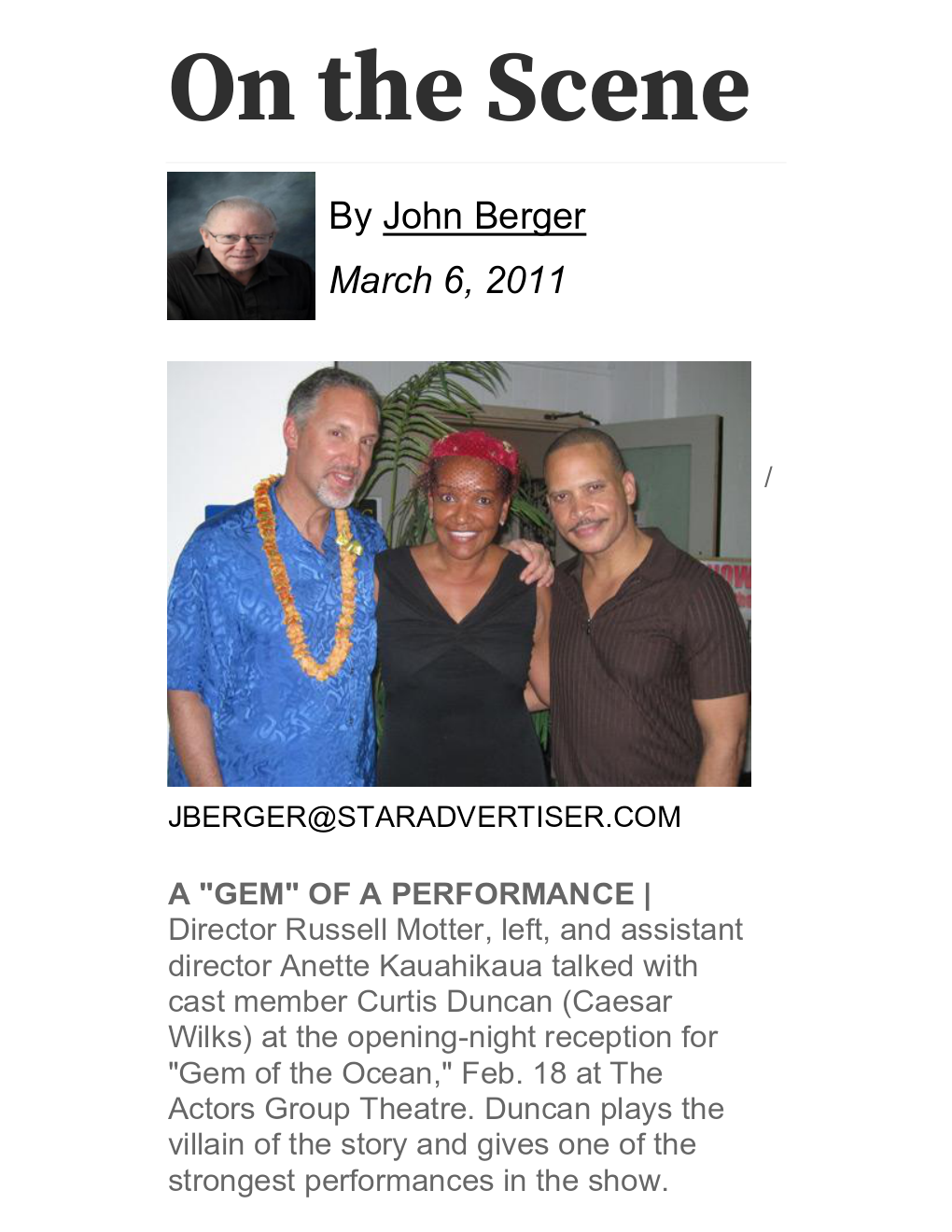


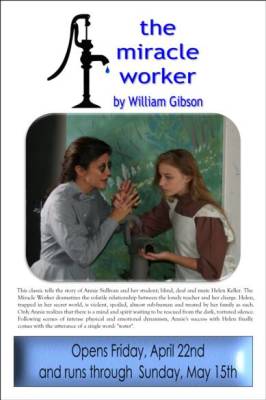
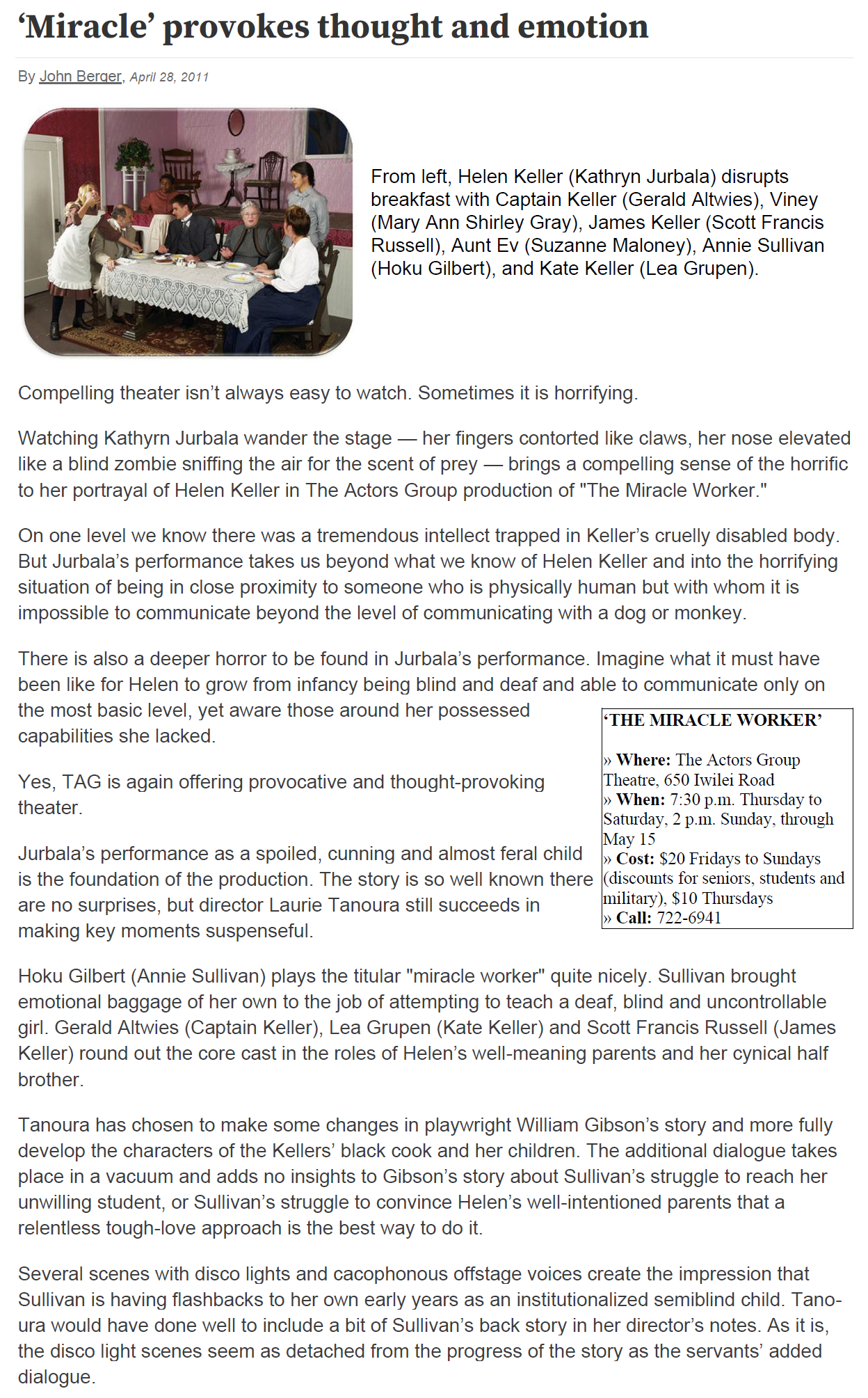

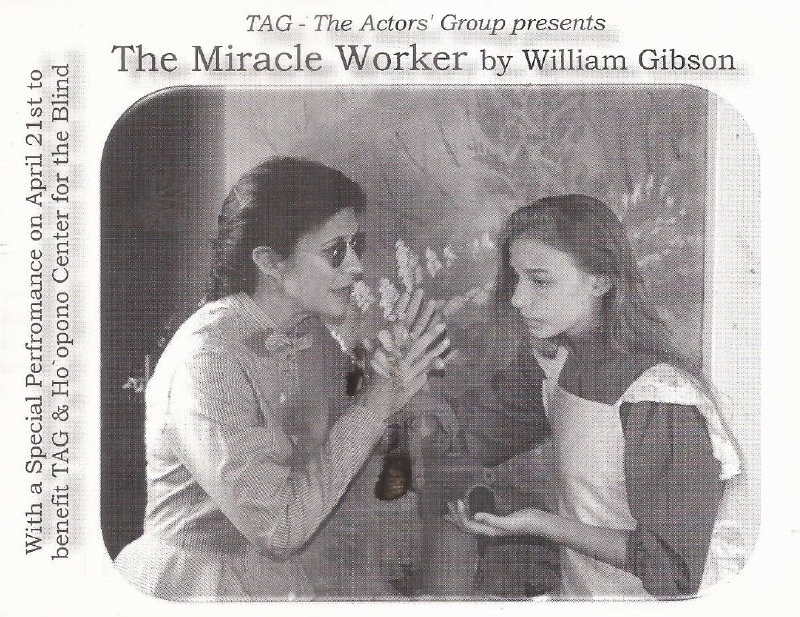
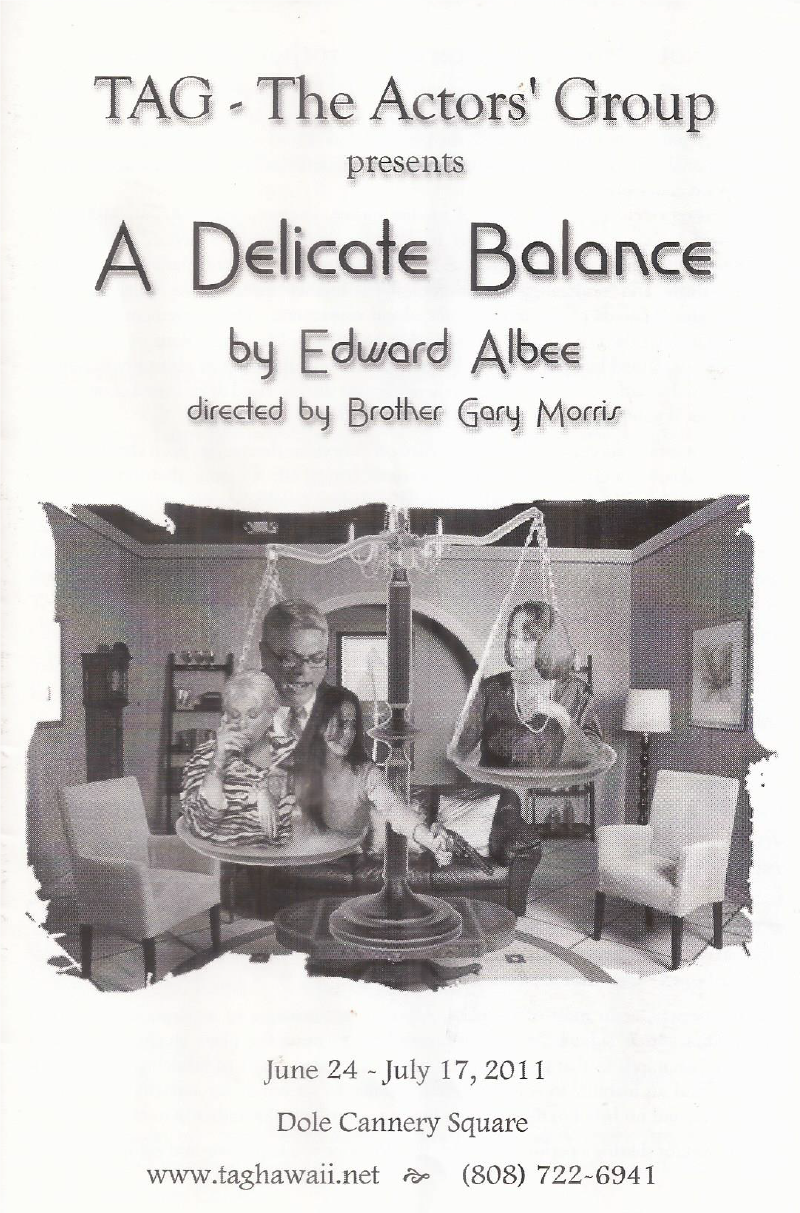
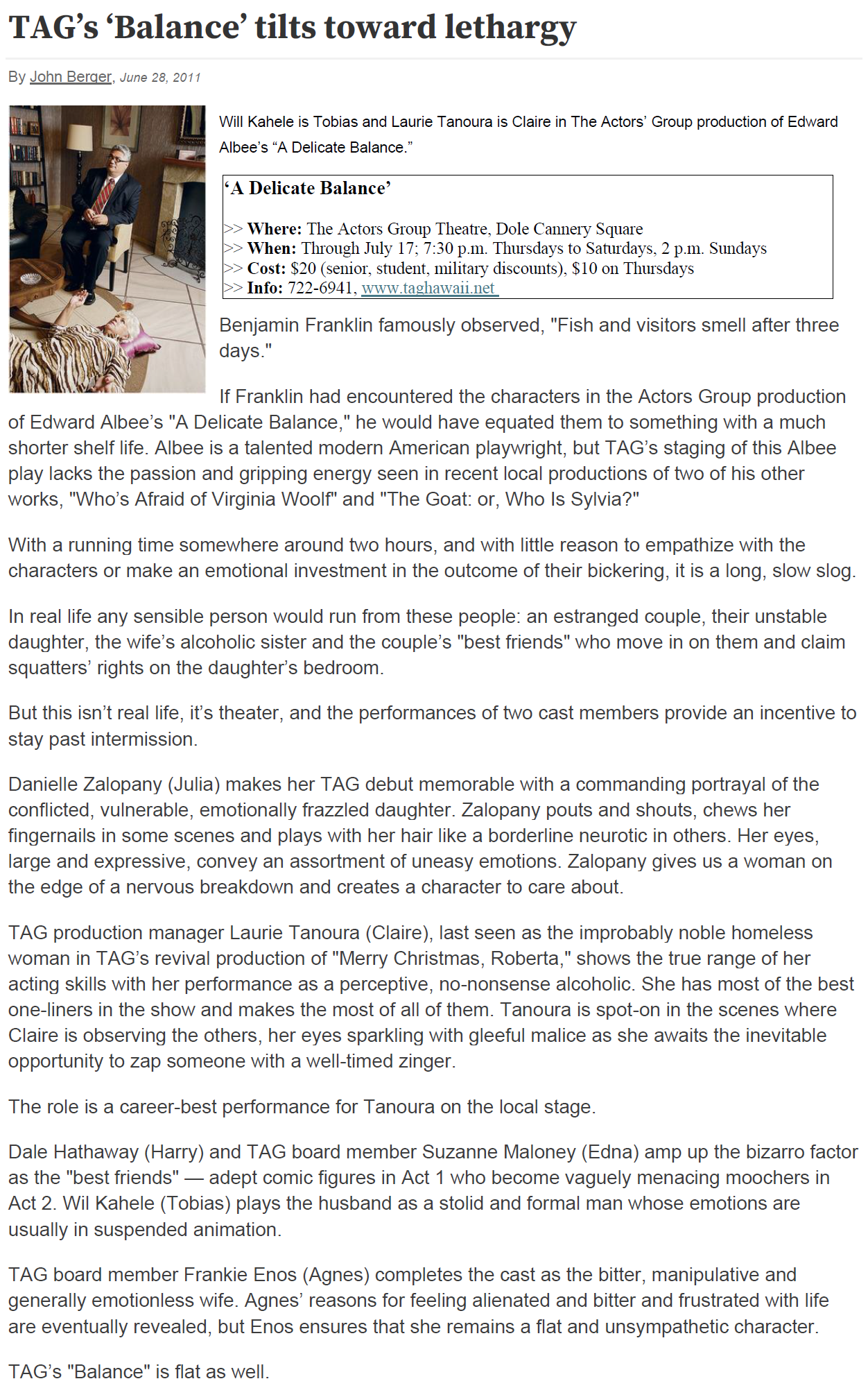
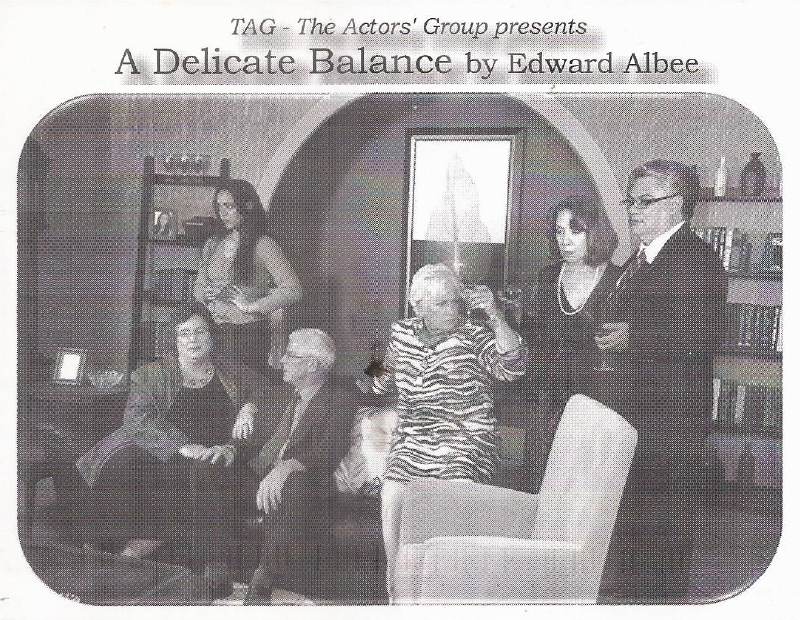
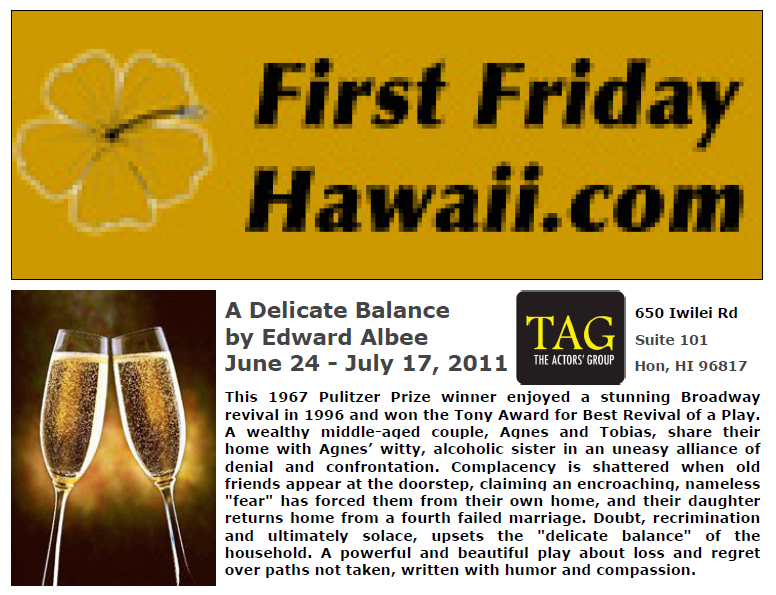
Comments are closed.